Human Resource Management and Development
VerifiedAdded on 2020/07/22
|24
|7742
|157
AI Summary
This assignment provides an overview of human resource management and development, covering various topics such as strategic HRM, organizational development, and change. It includes references to relevant studies and sources, making it a valuable resource for students and professionals in the field.
Contribute Materials
Your contribution can guide someone’s learning journey. Share your
documents today.
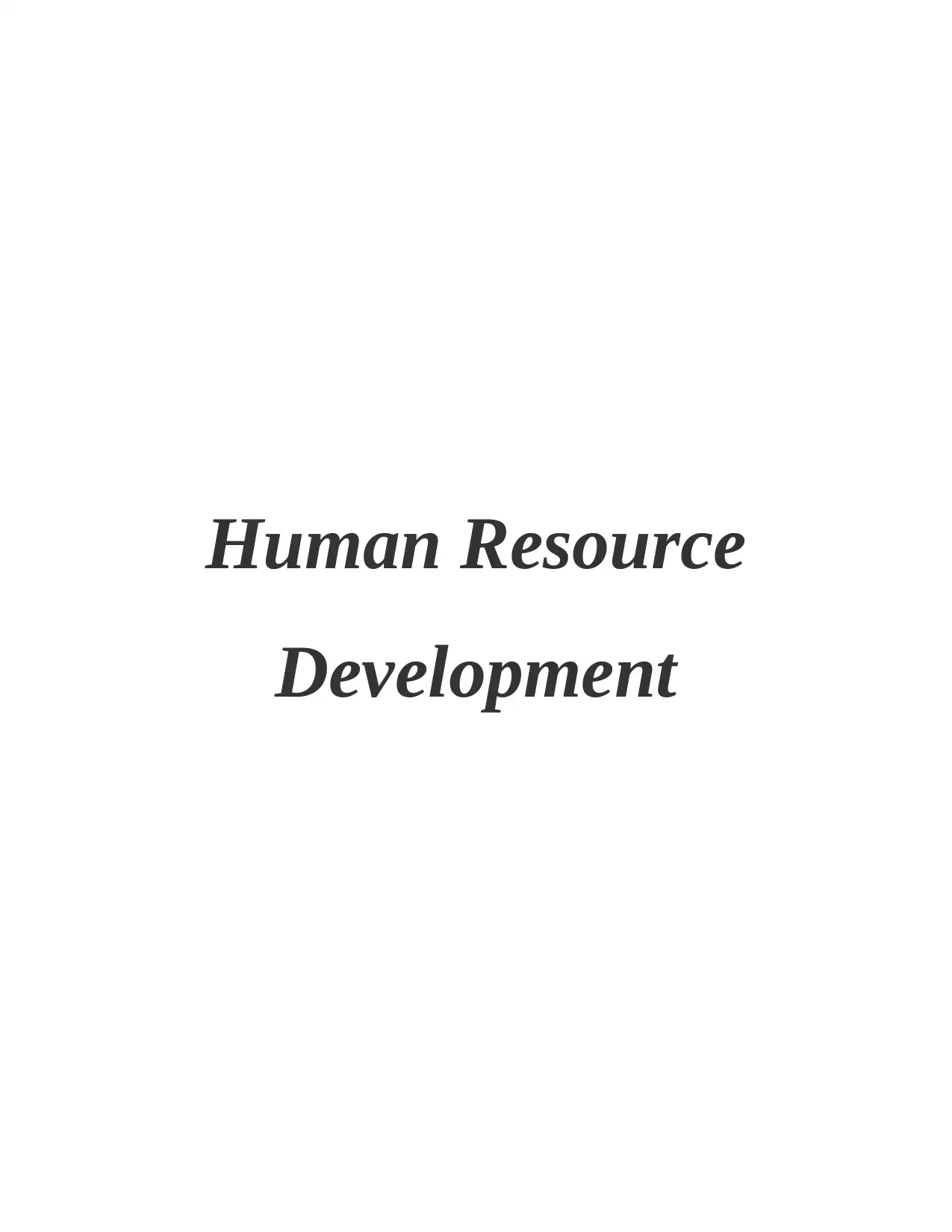
Human Resource
Development
Development
Secure Best Marks with AI Grader
Need help grading? Try our AI Grader for instant feedback on your assignments.
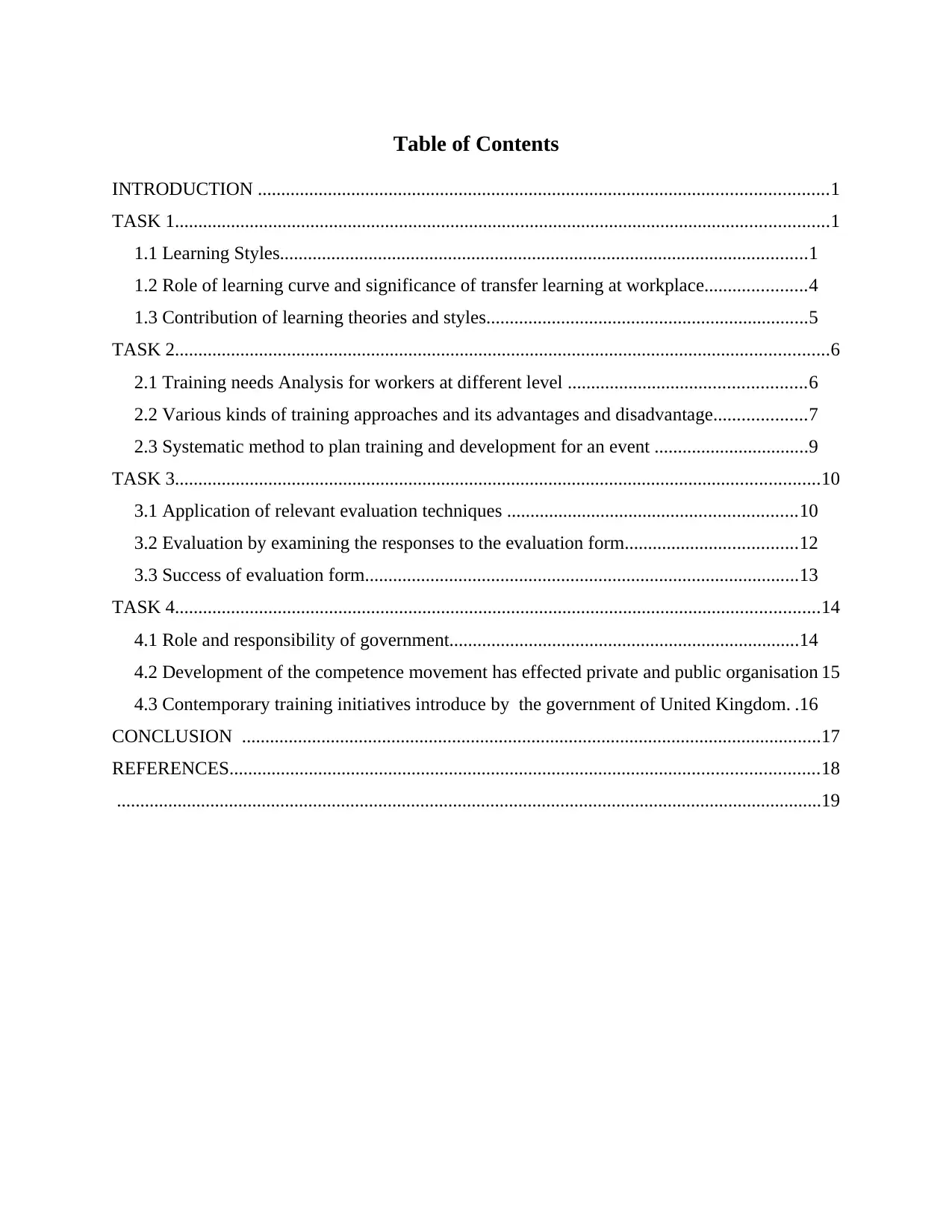
Table of Contents
INTRODUCTION ..........................................................................................................................1
TASK 1............................................................................................................................................1
1.1 Learning Styles.................................................................................................................1
1.2 Role of learning curve and significance of transfer learning at workplace......................4
1.3 Contribution of learning theories and styles.....................................................................5
TASK 2............................................................................................................................................6
2.1 Training needs Analysis for workers at different level ...................................................6
2.2 Various kinds of training approaches and its advantages and disadvantage....................7
2.3 Systematic method to plan training and development for an event .................................9
TASK 3..........................................................................................................................................10
3.1 Application of relevant evaluation techniques ..............................................................10
3.2 Evaluation by examining the responses to the evaluation form.....................................12
3.3 Success of evaluation form.............................................................................................13
TASK 4..........................................................................................................................................14
4.1 Role and responsibility of government...........................................................................14
4.2 Development of the competence movement has effected private and public organisation 15
4.3 Contemporary training initiatives introduce by the government of United Kingdom. .16
CONCLUSION ............................................................................................................................17
REFERENCES..............................................................................................................................18
.......................................................................................................................................................19
INTRODUCTION ..........................................................................................................................1
TASK 1............................................................................................................................................1
1.1 Learning Styles.................................................................................................................1
1.2 Role of learning curve and significance of transfer learning at workplace......................4
1.3 Contribution of learning theories and styles.....................................................................5
TASK 2............................................................................................................................................6
2.1 Training needs Analysis for workers at different level ...................................................6
2.2 Various kinds of training approaches and its advantages and disadvantage....................7
2.3 Systematic method to plan training and development for an event .................................9
TASK 3..........................................................................................................................................10
3.1 Application of relevant evaluation techniques ..............................................................10
3.2 Evaluation by examining the responses to the evaluation form.....................................12
3.3 Success of evaluation form.............................................................................................13
TASK 4..........................................................................................................................................14
4.1 Role and responsibility of government...........................................................................14
4.2 Development of the competence movement has effected private and public organisation 15
4.3 Contemporary training initiatives introduce by the government of United Kingdom. .16
CONCLUSION ............................................................................................................................17
REFERENCES..............................................................................................................................18
.......................................................................................................................................................19
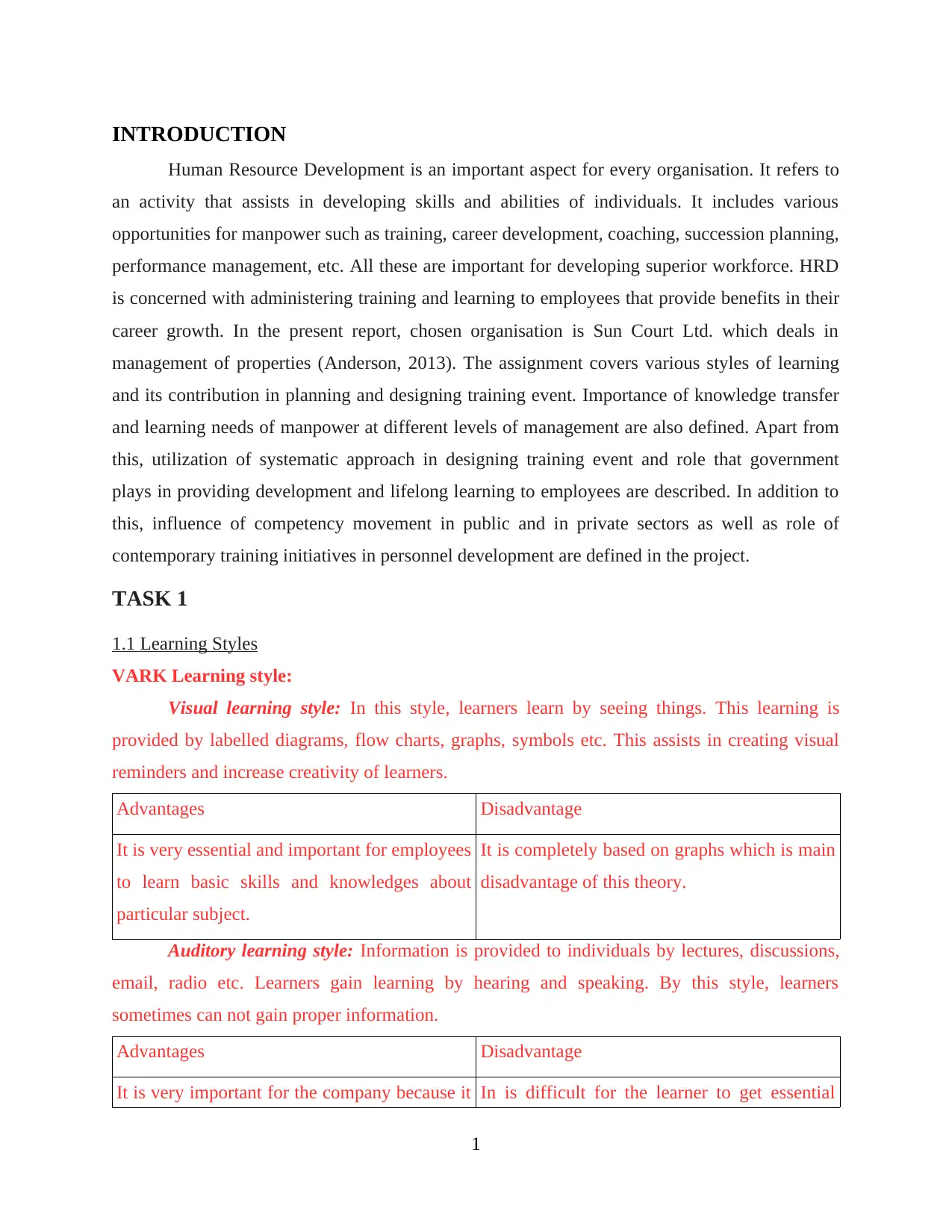
INTRODUCTION
Human Resource Development is an important aspect for every organisation. It refers to
an activity that assists in developing skills and abilities of individuals. It includes various
opportunities for manpower such as training, career development, coaching, succession planning,
performance management, etc. All these are important for developing superior workforce. HRD
is concerned with administering training and learning to employees that provide benefits in their
career growth. In the present report, chosen organisation is Sun Court Ltd. which deals in
management of properties (Anderson, 2013). The assignment covers various styles of learning
and its contribution in planning and designing training event. Importance of knowledge transfer
and learning needs of manpower at different levels of management are also defined. Apart from
this, utilization of systematic approach in designing training event and role that government
plays in providing development and lifelong learning to employees are described. In addition to
this, influence of competency movement in public and in private sectors as well as role of
contemporary training initiatives in personnel development are defined in the project.
TASK 1
1.1 Learning Styles
VARK Learning style:
Visual learning style: In this style, learners learn by seeing things. This learning is
provided by labelled diagrams, flow charts, graphs, symbols etc. This assists in creating visual
reminders and increase creativity of learners.
Advantages Disadvantage
It is very essential and important for employees
to learn basic skills and knowledges about
particular subject.
It is completely based on graphs which is main
disadvantage of this theory.
Auditory learning style: Information is provided to individuals by lectures, discussions,
email, radio etc. Learners gain learning by hearing and speaking. By this style, learners
sometimes can not gain proper information.
Advantages Disadvantage
It is very important for the company because it In is difficult for the learner to get essential
1
Human Resource Development is an important aspect for every organisation. It refers to
an activity that assists in developing skills and abilities of individuals. It includes various
opportunities for manpower such as training, career development, coaching, succession planning,
performance management, etc. All these are important for developing superior workforce. HRD
is concerned with administering training and learning to employees that provide benefits in their
career growth. In the present report, chosen organisation is Sun Court Ltd. which deals in
management of properties (Anderson, 2013). The assignment covers various styles of learning
and its contribution in planning and designing training event. Importance of knowledge transfer
and learning needs of manpower at different levels of management are also defined. Apart from
this, utilization of systematic approach in designing training event and role that government
plays in providing development and lifelong learning to employees are described. In addition to
this, influence of competency movement in public and in private sectors as well as role of
contemporary training initiatives in personnel development are defined in the project.
TASK 1
1.1 Learning Styles
VARK Learning style:
Visual learning style: In this style, learners learn by seeing things. This learning is
provided by labelled diagrams, flow charts, graphs, symbols etc. This assists in creating visual
reminders and increase creativity of learners.
Advantages Disadvantage
It is very essential and important for employees
to learn basic skills and knowledges about
particular subject.
It is completely based on graphs which is main
disadvantage of this theory.
Auditory learning style: Information is provided to individuals by lectures, discussions,
email, radio etc. Learners gain learning by hearing and speaking. By this style, learners
sometimes can not gain proper information.
Advantages Disadvantage
It is very important for the company because it In is difficult for the learner to get essential
1

gives entire information related to business
operations.
information and data.
Read/ write learning: In this, learners learn by reading and writing things. They gain
learning by displayed information. This style assists the learner in understanding things in better
manner.
Advantages Disadvantage
This types of learning style help the learner in
order to learn by writing things.
It is not good for the learner to learn accurate
information regarding business profitability.
Kinaesthetic learning style: This style includes practical learning. Individuals learn by
doing practical tasks. It assists the learner in doing their work in better manner.
Advantages Disadvantage
It is very essential and foremost style in order
to encourage practical learning of employees.
It is difficult in order to identify their better
skills and knowledge.
Behaviourist learning theory: According to this theory, learning is nothing. It is the
acquisition of behaviour on the basis of environmental situations.
Advantages Disadvantage
It emphasize on environment design to
optimize learning.
Feedbacks are used to alter the behaviour of an
individual in the required direction.
Cognitive learning theory: This theory includes second language learning as a reasoned
and conscious thinking process, involving deliberate use of strategies.
Advantages Disadvantage
This approach assumes that responses are the
result of intentional patterning and insight.
It emphasize on mental activities of learner.
Honey and Mumford learning style:
The model is given by Peter Honey and Alan Mumford in year 1986. They build
questionnaire instead of directly asking people about their learning. It probes general behaviour
tendencies of individual. As per this model, learner should know about their own learning styles.
It helps them in making smarter decisions. Four preferences are given in this model:
2
operations.
information and data.
Read/ write learning: In this, learners learn by reading and writing things. They gain
learning by displayed information. This style assists the learner in understanding things in better
manner.
Advantages Disadvantage
This types of learning style help the learner in
order to learn by writing things.
It is not good for the learner to learn accurate
information regarding business profitability.
Kinaesthetic learning style: This style includes practical learning. Individuals learn by
doing practical tasks. It assists the learner in doing their work in better manner.
Advantages Disadvantage
It is very essential and foremost style in order
to encourage practical learning of employees.
It is difficult in order to identify their better
skills and knowledge.
Behaviourist learning theory: According to this theory, learning is nothing. It is the
acquisition of behaviour on the basis of environmental situations.
Advantages Disadvantage
It emphasize on environment design to
optimize learning.
Feedbacks are used to alter the behaviour of an
individual in the required direction.
Cognitive learning theory: This theory includes second language learning as a reasoned
and conscious thinking process, involving deliberate use of strategies.
Advantages Disadvantage
This approach assumes that responses are the
result of intentional patterning and insight.
It emphasize on mental activities of learner.
Honey and Mumford learning style:
The model is given by Peter Honey and Alan Mumford in year 1986. They build
questionnaire instead of directly asking people about their learning. It probes general behaviour
tendencies of individual. As per this model, learner should know about their own learning styles.
It helps them in making smarter decisions. Four preferences are given in this model:
2
Secure Best Marks with AI Grader
Need help grading? Try our AI Grader for instant feedback on your assignments.
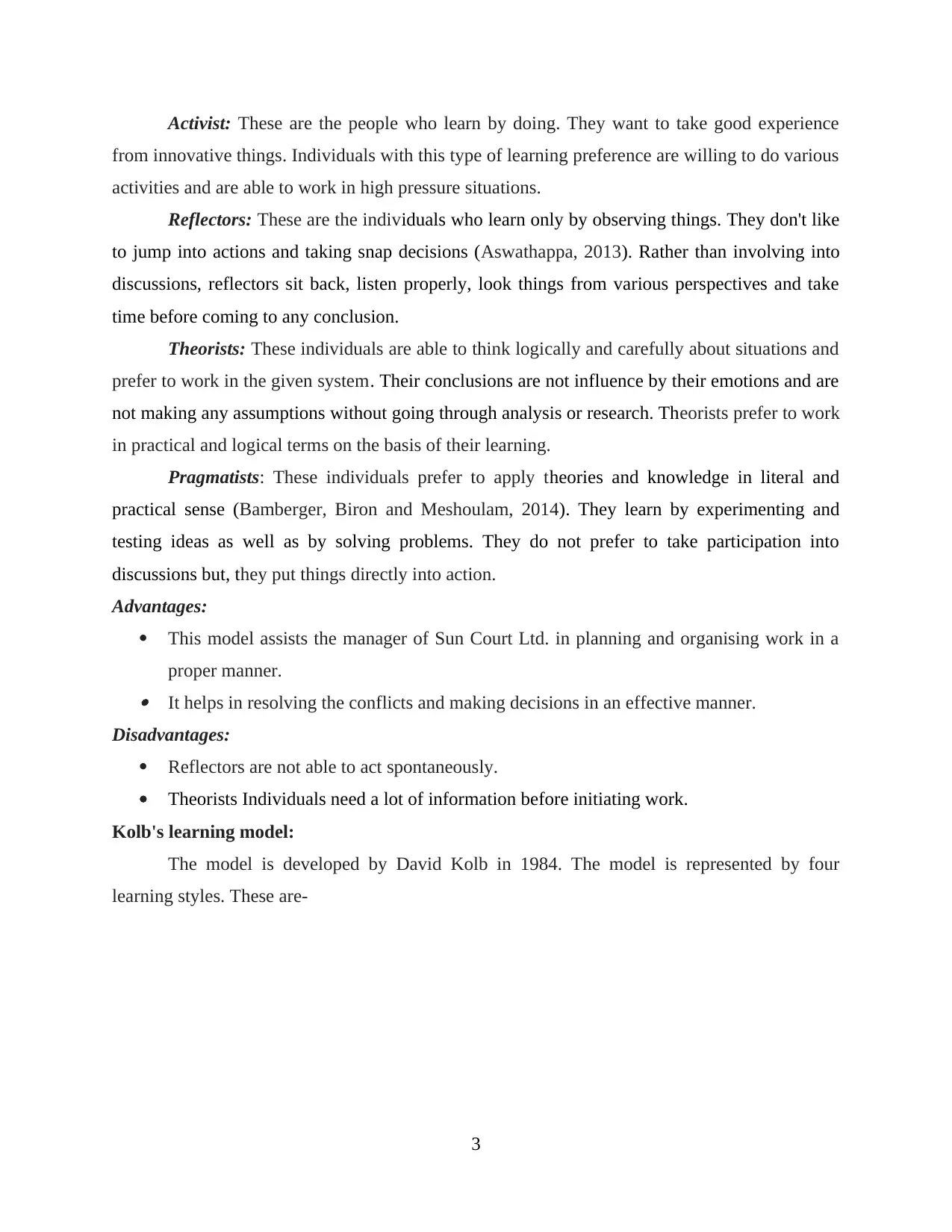
Activist: These are the people who learn by doing. They want to take good experience
from innovative things. Individuals with this type of learning preference are willing to do various
activities and are able to work in high pressure situations.
Reflectors: These are the individuals who learn only by observing things. They don't like
to jump into actions and taking snap decisions (Aswathappa, 2013). Rather than involving into
discussions, reflectors sit back, listen properly, look things from various perspectives and take
time before coming to any conclusion.
Theorists: These individuals are able to think logically and carefully about situations and
prefer to work in the given system. Their conclusions are not influence by their emotions and are
not making any assumptions without going through analysis or research. Theorists prefer to work
in practical and logical terms on the basis of their learning.
Pragmatists: These individuals prefer to apply theories and knowledge in literal and
practical sense (Bamberger, Biron and Meshoulam, 2014). They learn by experimenting and
testing ideas as well as by solving problems. They do not prefer to take participation into
discussions but, they put things directly into action.
Advantages:
This model assists the manager of Sun Court Ltd. in planning and organising work in a
proper manner. It helps in resolving the conflicts and making decisions in an effective manner.
Disadvantages:
Reflectors are not able to act spontaneously.
Theorists Individuals need a lot of information before initiating work.
Kolb's learning model:
The model is developed by David Kolb in 1984. The model is represented by four
learning styles. These are-
3
from innovative things. Individuals with this type of learning preference are willing to do various
activities and are able to work in high pressure situations.
Reflectors: These are the individuals who learn only by observing things. They don't like
to jump into actions and taking snap decisions (Aswathappa, 2013). Rather than involving into
discussions, reflectors sit back, listen properly, look things from various perspectives and take
time before coming to any conclusion.
Theorists: These individuals are able to think logically and carefully about situations and
prefer to work in the given system. Their conclusions are not influence by their emotions and are
not making any assumptions without going through analysis or research. Theorists prefer to work
in practical and logical terms on the basis of their learning.
Pragmatists: These individuals prefer to apply theories and knowledge in literal and
practical sense (Bamberger, Biron and Meshoulam, 2014). They learn by experimenting and
testing ideas as well as by solving problems. They do not prefer to take participation into
discussions but, they put things directly into action.
Advantages:
This model assists the manager of Sun Court Ltd. in planning and organising work in a
proper manner. It helps in resolving the conflicts and making decisions in an effective manner.
Disadvantages:
Reflectors are not able to act spontaneously.
Theorists Individuals need a lot of information before initiating work.
Kolb's learning model:
The model is developed by David Kolb in 1984. The model is represented by four
learning styles. These are-
3
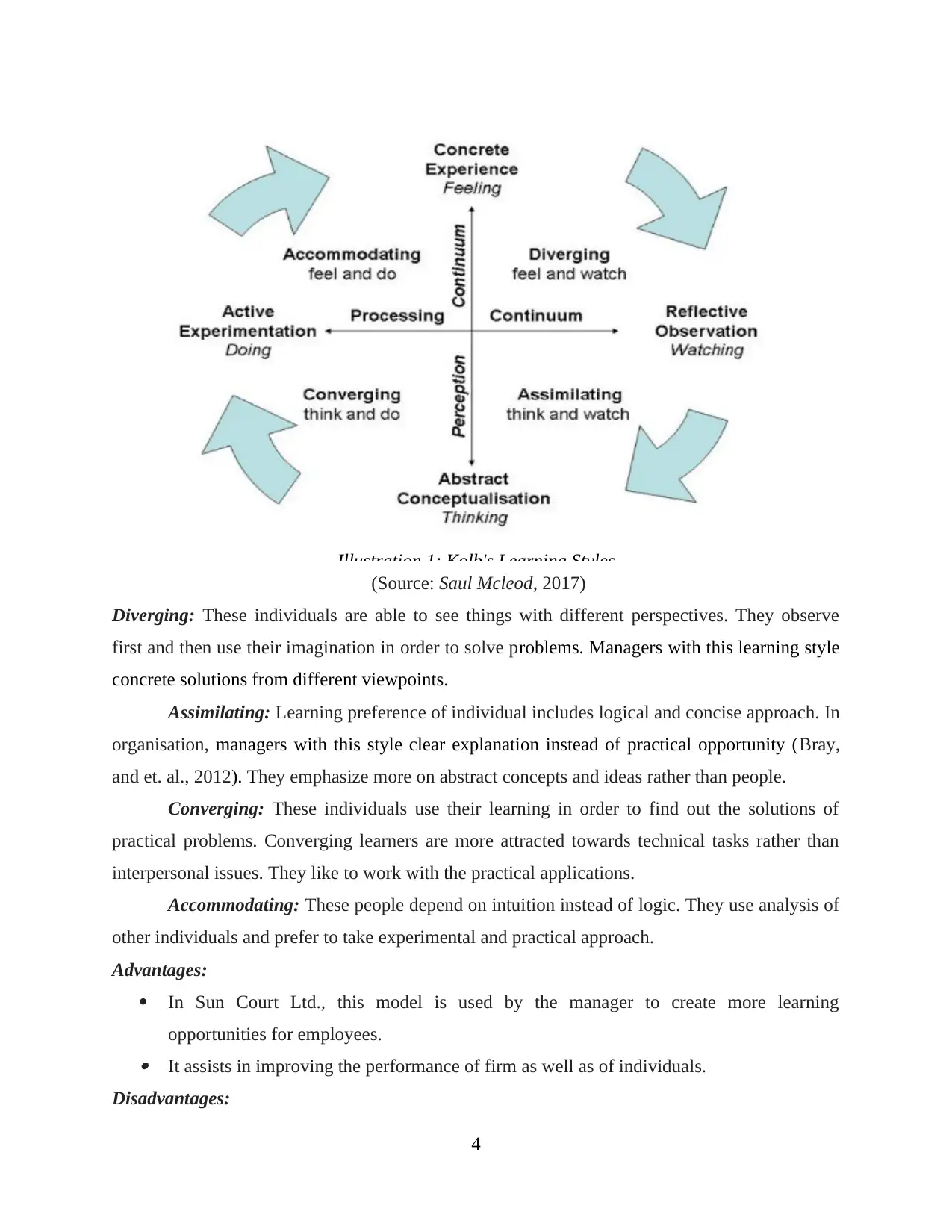
Illustration 1: Kolb's Learning Styles
(Source: Saul Mcleod, 2017)
Diverging: These individuals are able to see things with different perspectives. They observe
first and then use their imagination in order to solve problems. Managers with this learning style
concrete solutions from different viewpoints.
Assimilating: Learning preference of individual includes logical and concise approach. In
organisation, managers with this style clear explanation instead of practical opportunity (Bray,
and et. al., 2012). They emphasize more on abstract concepts and ideas rather than people.
Converging: These individuals use their learning in order to find out the solutions of
practical problems. Converging learners are more attracted towards technical tasks rather than
interpersonal issues. They like to work with the practical applications.
Accommodating: These people depend on intuition instead of logic. They use analysis of
other individuals and prefer to take experimental and practical approach.
Advantages:
In Sun Court Ltd., this model is used by the manager to create more learning
opportunities for employees. It assists in improving the performance of firm as well as of individuals.
Disadvantages:
4
(Source: Saul Mcleod, 2017)
Diverging: These individuals are able to see things with different perspectives. They observe
first and then use their imagination in order to solve problems. Managers with this learning style
concrete solutions from different viewpoints.
Assimilating: Learning preference of individual includes logical and concise approach. In
organisation, managers with this style clear explanation instead of practical opportunity (Bray,
and et. al., 2012). They emphasize more on abstract concepts and ideas rather than people.
Converging: These individuals use their learning in order to find out the solutions of
practical problems. Converging learners are more attracted towards technical tasks rather than
interpersonal issues. They like to work with the practical applications.
Accommodating: These people depend on intuition instead of logic. They use analysis of
other individuals and prefer to take experimental and practical approach.
Advantages:
In Sun Court Ltd., this model is used by the manager to create more learning
opportunities for employees. It assists in improving the performance of firm as well as of individuals.
Disadvantages:
4
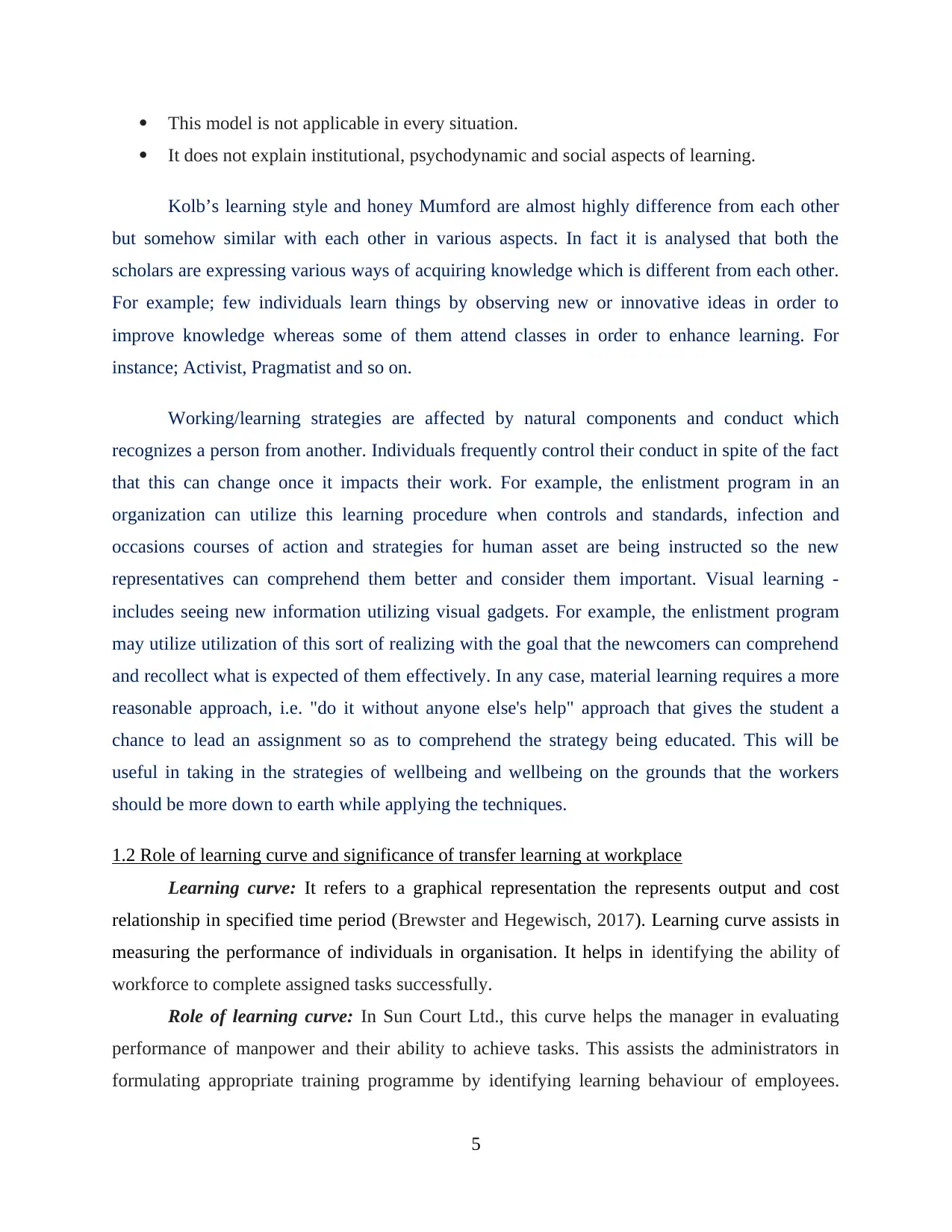
This model is not applicable in every situation.
It does not explain institutional, psychodynamic and social aspects of learning.
Kolb’s learning style and honey Mumford are almost highly difference from each other
but somehow similar with each other in various aspects. In fact it is analysed that both the
scholars are expressing various ways of acquiring knowledge which is different from each other.
For example; few individuals learn things by observing new or innovative ideas in order to
improve knowledge whereas some of them attend classes in order to enhance learning. For
instance; Activist, Pragmatist and so on.
Working/learning strategies are affected by natural components and conduct which
recognizes a person from another. Individuals frequently control their conduct in spite of the fact
that this can change once it impacts their work. For example, the enlistment program in an
organization can utilize this learning procedure when controls and standards, infection and
occasions courses of action and strategies for human asset are being instructed so the new
representatives can comprehend them better and consider them important. Visual learning -
includes seeing new information utilizing visual gadgets. For example, the enlistment program
may utilize utilization of this sort of realizing with the goal that the newcomers can comprehend
and recollect what is expected of them effectively. In any case, material learning requires a more
reasonable approach, i.e. "do it without anyone else's help" approach that gives the student a
chance to lead an assignment so as to comprehend the strategy being educated. This will be
useful in taking in the strategies of wellbeing and wellbeing on the grounds that the workers
should be more down to earth while applying the techniques.
1.2 Role of learning curve and significance of transfer learning at workplace
Learning curve: It refers to a graphical representation the represents output and cost
relationship in specified time period (Brewster and Hegewisch, 2017). Learning curve assists in
measuring the performance of individuals in organisation. It helps in identifying the ability of
workforce to complete assigned tasks successfully.
Role of learning curve: In Sun Court Ltd., this curve helps the manager in evaluating
performance of manpower and their ability to achieve tasks. This assists the administrators in
formulating appropriate training programme by identifying learning behaviour of employees.
5
It does not explain institutional, psychodynamic and social aspects of learning.
Kolb’s learning style and honey Mumford are almost highly difference from each other
but somehow similar with each other in various aspects. In fact it is analysed that both the
scholars are expressing various ways of acquiring knowledge which is different from each other.
For example; few individuals learn things by observing new or innovative ideas in order to
improve knowledge whereas some of them attend classes in order to enhance learning. For
instance; Activist, Pragmatist and so on.
Working/learning strategies are affected by natural components and conduct which
recognizes a person from another. Individuals frequently control their conduct in spite of the fact
that this can change once it impacts their work. For example, the enlistment program in an
organization can utilize this learning procedure when controls and standards, infection and
occasions courses of action and strategies for human asset are being instructed so the new
representatives can comprehend them better and consider them important. Visual learning -
includes seeing new information utilizing visual gadgets. For example, the enlistment program
may utilize utilization of this sort of realizing with the goal that the newcomers can comprehend
and recollect what is expected of them effectively. In any case, material learning requires a more
reasonable approach, i.e. "do it without anyone else's help" approach that gives the student a
chance to lead an assignment so as to comprehend the strategy being educated. This will be
useful in taking in the strategies of wellbeing and wellbeing on the grounds that the workers
should be more down to earth while applying the techniques.
1.2 Role of learning curve and significance of transfer learning at workplace
Learning curve: It refers to a graphical representation the represents output and cost
relationship in specified time period (Brewster and Hegewisch, 2017). Learning curve assists in
measuring the performance of individuals in organisation. It helps in identifying the ability of
workforce to complete assigned tasks successfully.
Role of learning curve: In Sun Court Ltd., this curve helps the manager in evaluating
performance of manpower and their ability to achieve tasks. This assists the administrators in
formulating appropriate training programme by identifying learning behaviour of employees.
5
Paraphrase This Document
Need a fresh take? Get an instant paraphrase of this document with our AI Paraphraser
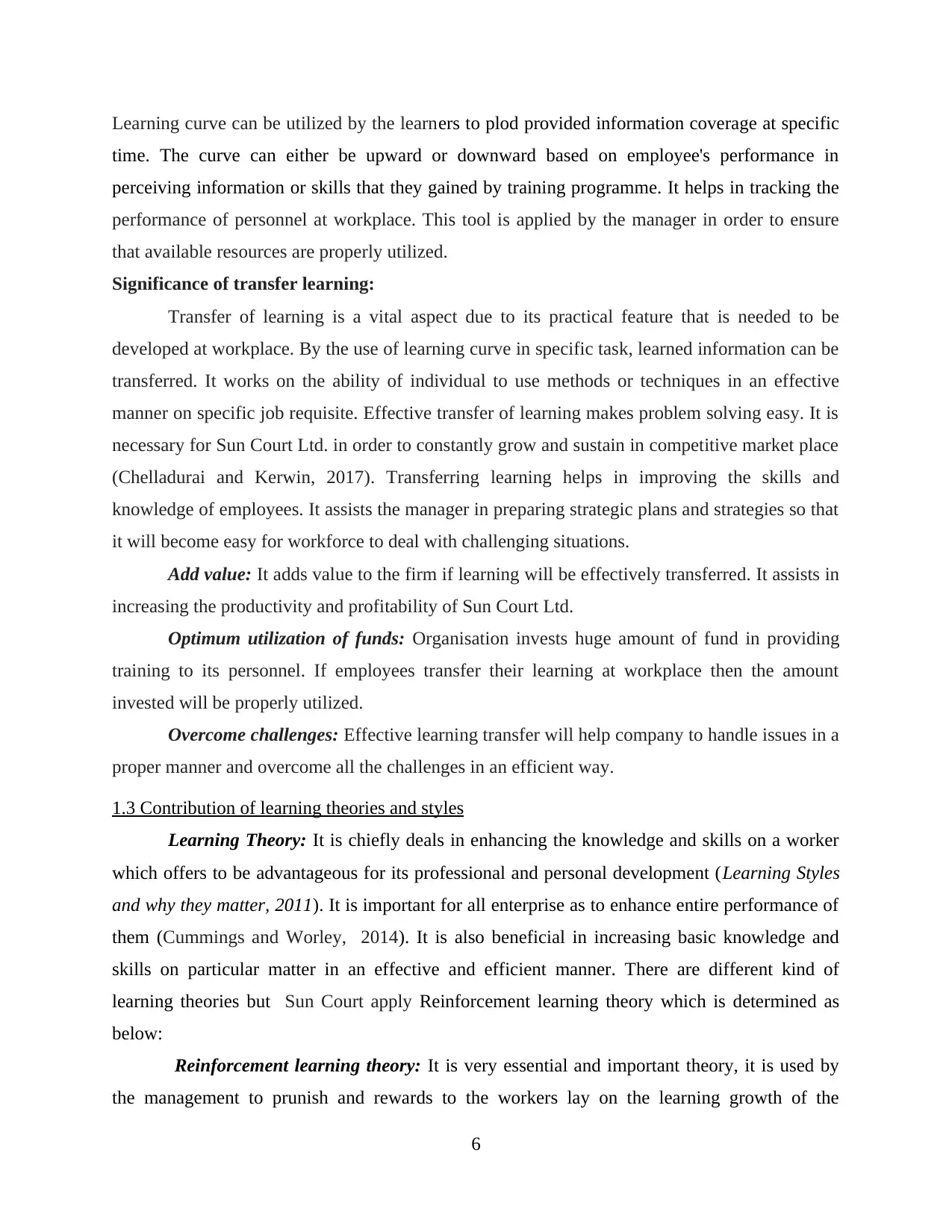
Learning curve can be utilized by the learners to plod provided information coverage at specific
time. The curve can either be upward or downward based on employee's performance in
perceiving information or skills that they gained by training programme. It helps in tracking the
performance of personnel at workplace. This tool is applied by the manager in order to ensure
that available resources are properly utilized.
Significance of transfer learning:
Transfer of learning is a vital aspect due to its practical feature that is needed to be
developed at workplace. By the use of learning curve in specific task, learned information can be
transferred. It works on the ability of individual to use methods or techniques in an effective
manner on specific job requisite. Effective transfer of learning makes problem solving easy. It is
necessary for Sun Court Ltd. in order to constantly grow and sustain in competitive market place
(Chelladurai and Kerwin, 2017). Transferring learning helps in improving the skills and
knowledge of employees. It assists the manager in preparing strategic plans and strategies so that
it will become easy for workforce to deal with challenging situations.
Add value: It adds value to the firm if learning will be effectively transferred. It assists in
increasing the productivity and profitability of Sun Court Ltd.
Optimum utilization of funds: Organisation invests huge amount of fund in providing
training to its personnel. If employees transfer their learning at workplace then the amount
invested will be properly utilized.
Overcome challenges: Effective learning transfer will help company to handle issues in a
proper manner and overcome all the challenges in an efficient way.
1.3 Contribution of learning theories and styles
Learning Theory: It is chiefly deals in enhancing the knowledge and skills on a worker
which offers to be advantageous for its professional and personal development (Learning Styles
and why they matter, 2011). It is important for all enterprise as to enhance entire performance of
them (Cummings and Worley, 2014). It is also beneficial in increasing basic knowledge and
skills on particular matter in an effective and efficient manner. There are different kind of
learning theories but Sun Court apply Reinforcement learning theory which is determined as
below:
Reinforcement learning theory: It is very essential and important theory, it is used by
the management to prunish and rewards to the workers lay on the learning growth of the
6
time. The curve can either be upward or downward based on employee's performance in
perceiving information or skills that they gained by training programme. It helps in tracking the
performance of personnel at workplace. This tool is applied by the manager in order to ensure
that available resources are properly utilized.
Significance of transfer learning:
Transfer of learning is a vital aspect due to its practical feature that is needed to be
developed at workplace. By the use of learning curve in specific task, learned information can be
transferred. It works on the ability of individual to use methods or techniques in an effective
manner on specific job requisite. Effective transfer of learning makes problem solving easy. It is
necessary for Sun Court Ltd. in order to constantly grow and sustain in competitive market place
(Chelladurai and Kerwin, 2017). Transferring learning helps in improving the skills and
knowledge of employees. It assists the manager in preparing strategic plans and strategies so that
it will become easy for workforce to deal with challenging situations.
Add value: It adds value to the firm if learning will be effectively transferred. It assists in
increasing the productivity and profitability of Sun Court Ltd.
Optimum utilization of funds: Organisation invests huge amount of fund in providing
training to its personnel. If employees transfer their learning at workplace then the amount
invested will be properly utilized.
Overcome challenges: Effective learning transfer will help company to handle issues in a
proper manner and overcome all the challenges in an efficient way.
1.3 Contribution of learning theories and styles
Learning Theory: It is chiefly deals in enhancing the knowledge and skills on a worker
which offers to be advantageous for its professional and personal development (Learning Styles
and why they matter, 2011). It is important for all enterprise as to enhance entire performance of
them (Cummings and Worley, 2014). It is also beneficial in increasing basic knowledge and
skills on particular matter in an effective and efficient manner. There are different kind of
learning theories but Sun Court apply Reinforcement learning theory which is determined as
below:
Reinforcement learning theory: It is very essential and important theory, it is used by
the management to prunish and rewards to the workers lay on the learning growth of the
6

workforce. It is also beneficial when designing and planning a learning event in an effective and
accurate way.
Gagne's Nine Events of Instruction: It is developed by the Robert Gagne which cover nine
phase process is known as instruction events. This model assist educators, trainers, and education
designers framework their training program.
1. Gaining Attention: Being the acquisition program by acquiring the better attention of the
scholar. In this they are motivate their employees towards its work and performance
(Daley, 2012). It can achieved by showing with the activity that occupy the person.
2. Informing person of the objective and goal: After increasing their whole attention, alter
the persons of the acquisition objectives to support them know what they learn during the
program.
3. Stimulating Recall of prior learning: It support the person make sense of fresh
information and data by concertinaing is to something which already something and
know they have already talented.
4. Presenting the Stimulus: It is present the fresh data to the person in order to increase
their basic skills and knowledge on specific matter.
5. Giving learning direction and guidelines: In this manager provide batter guidelines and
direction to work hard and achieve long term goals and objectives of company in limited
time period.
6. Eliciting performance: In this learners mainly acquired knowledge, skills and
behaviours. It give practices activities to actuate the learning procedures.
7. Providing feedback or command: In this person attempts to show their skills, give
immediate command of employees performance to facilitates and assess learning (Guest,
2011).
8. Assessing performance: In order to analysis the effectiveness and efficiency of the
instruction programs, managers test the worker to analysis if the due learning results have
been attained.
9. Raise retention : In this manger provide some resources in order to increase and transfer
of skills or knowledge. So in this they are capable in order to internalise the effective
knowledge and maximise her or his expertise.
7
accurate way.
Gagne's Nine Events of Instruction: It is developed by the Robert Gagne which cover nine
phase process is known as instruction events. This model assist educators, trainers, and education
designers framework their training program.
1. Gaining Attention: Being the acquisition program by acquiring the better attention of the
scholar. In this they are motivate their employees towards its work and performance
(Daley, 2012). It can achieved by showing with the activity that occupy the person.
2. Informing person of the objective and goal: After increasing their whole attention, alter
the persons of the acquisition objectives to support them know what they learn during the
program.
3. Stimulating Recall of prior learning: It support the person make sense of fresh
information and data by concertinaing is to something which already something and
know they have already talented.
4. Presenting the Stimulus: It is present the fresh data to the person in order to increase
their basic skills and knowledge on specific matter.
5. Giving learning direction and guidelines: In this manager provide batter guidelines and
direction to work hard and achieve long term goals and objectives of company in limited
time period.
6. Eliciting performance: In this learners mainly acquired knowledge, skills and
behaviours. It give practices activities to actuate the learning procedures.
7. Providing feedback or command: In this person attempts to show their skills, give
immediate command of employees performance to facilitates and assess learning (Guest,
2011).
8. Assessing performance: In order to analysis the effectiveness and efficiency of the
instruction programs, managers test the worker to analysis if the due learning results have
been attained.
9. Raise retention : In this manger provide some resources in order to increase and transfer
of skills or knowledge. So in this they are capable in order to internalise the effective
knowledge and maximise her or his expertise.
7
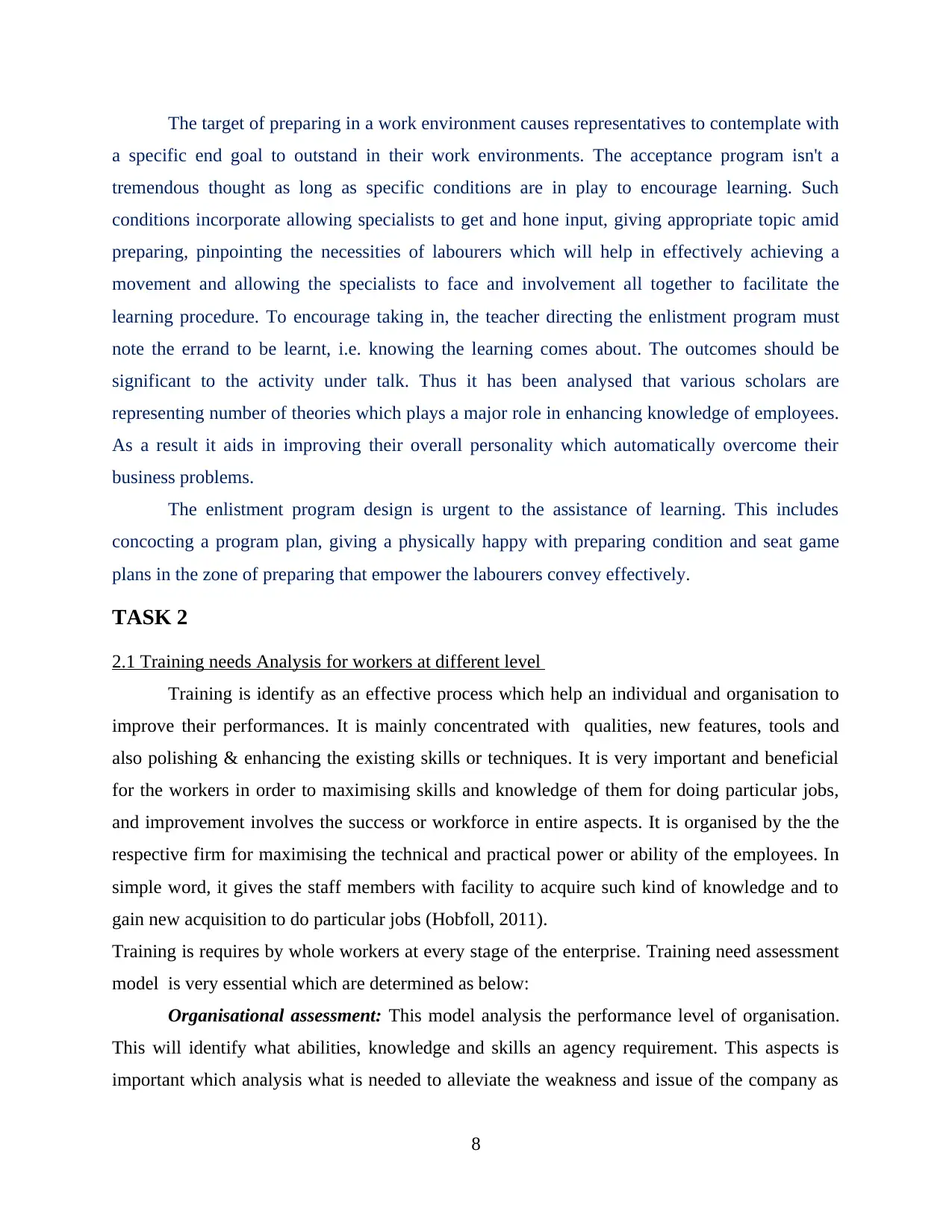
The target of preparing in a work environment causes representatives to contemplate with
a specific end goal to outstand in their work environments. The acceptance program isn't a
tremendous thought as long as specific conditions are in play to encourage learning. Such
conditions incorporate allowing specialists to get and hone input, giving appropriate topic amid
preparing, pinpointing the necessities of labourers which will help in effectively achieving a
movement and allowing the specialists to face and involvement all together to facilitate the
learning procedure. To encourage taking in, the teacher directing the enlistment program must
note the errand to be learnt, i.e. knowing the learning comes about. The outcomes should be
significant to the activity under talk. Thus it has been analysed that various scholars are
representing number of theories which plays a major role in enhancing knowledge of employees.
As a result it aids in improving their overall personality which automatically overcome their
business problems.
The enlistment program design is urgent to the assistance of learning. This includes
concocting a program plan, giving a physically happy with preparing condition and seat game
plans in the zone of preparing that empower the labourers convey effectively.
TASK 2
2.1 Training needs Analysis for workers at different level
Training is identify as an effective process which help an individual and organisation to
improve their performances. It is mainly concentrated with qualities, new features, tools and
also polishing & enhancing the existing skills or techniques. It is very important and beneficial
for the workers in order to maximising skills and knowledge of them for doing particular jobs,
and improvement involves the success or workforce in entire aspects. It is organised by the the
respective firm for maximising the technical and practical power or ability of the employees. In
simple word, it gives the staff members with facility to acquire such kind of knowledge and to
gain new acquisition to do particular jobs (Hobfoll, 2011).
Training is requires by whole workers at every stage of the enterprise. Training need assessment
model is very essential which are determined as below:
Organisational assessment: This model analysis the performance level of organisation.
This will identify what abilities, knowledge and skills an agency requirement. This aspects is
important which analysis what is needed to alleviate the weakness and issue of the company as
8
a specific end goal to outstand in their work environments. The acceptance program isn't a
tremendous thought as long as specific conditions are in play to encourage learning. Such
conditions incorporate allowing specialists to get and hone input, giving appropriate topic amid
preparing, pinpointing the necessities of labourers which will help in effectively achieving a
movement and allowing the specialists to face and involvement all together to facilitate the
learning procedure. To encourage taking in, the teacher directing the enlistment program must
note the errand to be learnt, i.e. knowing the learning comes about. The outcomes should be
significant to the activity under talk. Thus it has been analysed that various scholars are
representing number of theories which plays a major role in enhancing knowledge of employees.
As a result it aids in improving their overall personality which automatically overcome their
business problems.
The enlistment program design is urgent to the assistance of learning. This includes
concocting a program plan, giving a physically happy with preparing condition and seat game
plans in the zone of preparing that empower the labourers convey effectively.
TASK 2
2.1 Training needs Analysis for workers at different level
Training is identify as an effective process which help an individual and organisation to
improve their performances. It is mainly concentrated with qualities, new features, tools and
also polishing & enhancing the existing skills or techniques. It is very important and beneficial
for the workers in order to maximising skills and knowledge of them for doing particular jobs,
and improvement involves the success or workforce in entire aspects. It is organised by the the
respective firm for maximising the technical and practical power or ability of the employees. In
simple word, it gives the staff members with facility to acquire such kind of knowledge and to
gain new acquisition to do particular jobs (Hobfoll, 2011).
Training is requires by whole workers at every stage of the enterprise. Training need assessment
model is very essential which are determined as below:
Organisational assessment: This model analysis the performance level of organisation.
This will identify what abilities, knowledge and skills an agency requirement. This aspects is
important which analysis what is needed to alleviate the weakness and issue of the company as
8
Secure Best Marks with AI Grader
Need help grading? Try our AI Grader for instant feedback on your assignments.
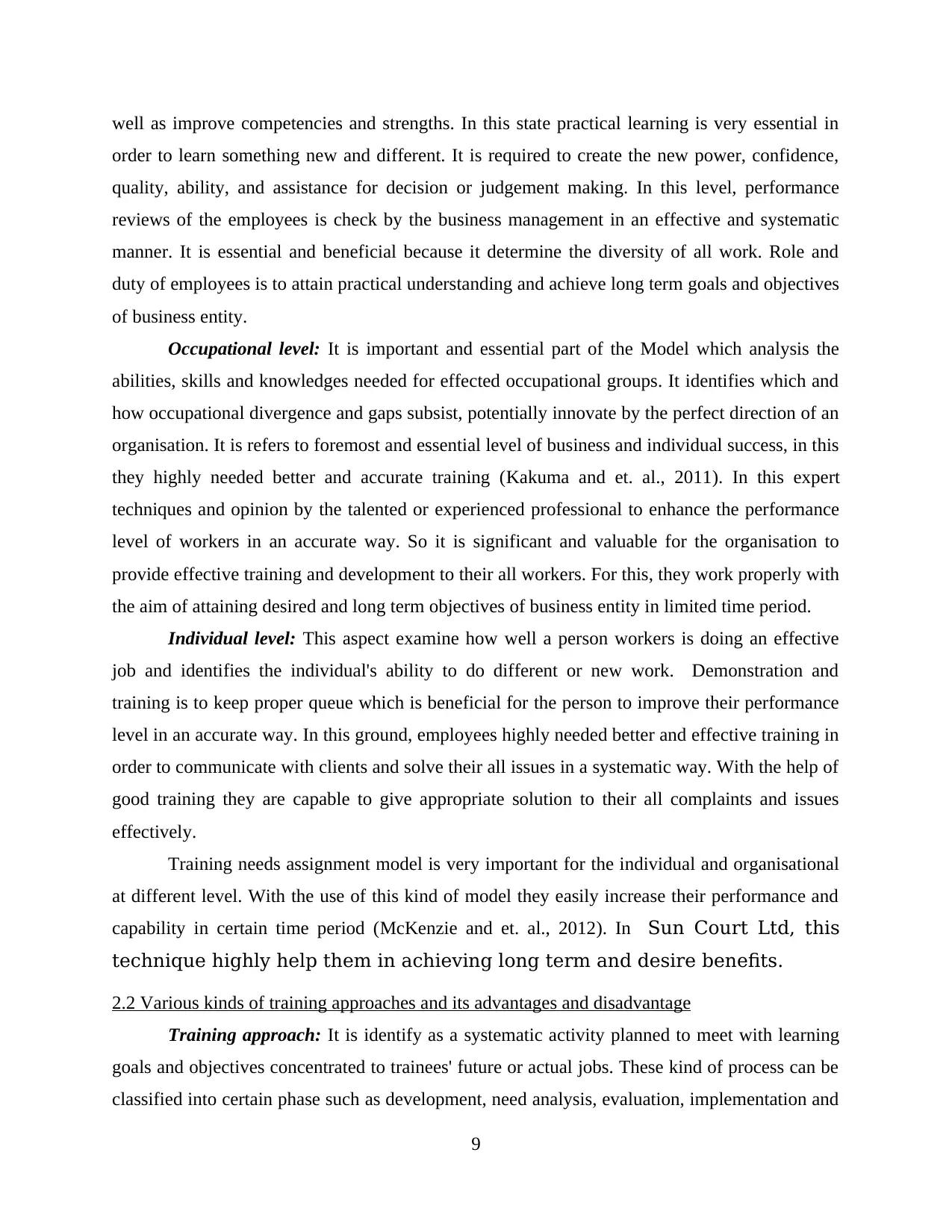
well as improve competencies and strengths. In this state practical learning is very essential in
order to learn something new and different. It is required to create the new power, confidence,
quality, ability, and assistance for decision or judgement making. In this level, performance
reviews of the employees is check by the business management in an effective and systematic
manner. It is essential and beneficial because it determine the diversity of all work. Role and
duty of employees is to attain practical understanding and achieve long term goals and objectives
of business entity.
Occupational level: It is important and essential part of the Model which analysis the
abilities, skills and knowledges needed for effected occupational groups. It identifies which and
how occupational divergence and gaps subsist, potentially innovate by the perfect direction of an
organisation. It is refers to foremost and essential level of business and individual success, in this
they highly needed better and accurate training (Kakuma and et. al., 2011). In this expert
techniques and opinion by the talented or experienced professional to enhance the performance
level of workers in an accurate way. So it is significant and valuable for the organisation to
provide effective training and development to their all workers. For this, they work properly with
the aim of attaining desired and long term objectives of business entity in limited time period.
Individual level: This aspect examine how well a person workers is doing an effective
job and identifies the individual's ability to do different or new work. Demonstration and
training is to keep proper queue which is beneficial for the person to improve their performance
level in an accurate way. In this ground, employees highly needed better and effective training in
order to communicate with clients and solve their all issues in a systematic way. With the help of
good training they are capable to give appropriate solution to their all complaints and issues
effectively.
Training needs assignment model is very important for the individual and organisational
at different level. With the use of this kind of model they easily increase their performance and
capability in certain time period (McKenzie and et. al., 2012). In Sun Court Ltd, this
technique highly help them in achieving long term and desire benefits.
2.2 Various kinds of training approaches and its advantages and disadvantage
Training approach: It is identify as a systematic activity planned to meet with learning
goals and objectives concentrated to trainees' future or actual jobs. These kind of process can be
classified into certain phase such as development, need analysis, evaluation, implementation and
9
order to learn something new and different. It is required to create the new power, confidence,
quality, ability, and assistance for decision or judgement making. In this level, performance
reviews of the employees is check by the business management in an effective and systematic
manner. It is essential and beneficial because it determine the diversity of all work. Role and
duty of employees is to attain practical understanding and achieve long term goals and objectives
of business entity.
Occupational level: It is important and essential part of the Model which analysis the
abilities, skills and knowledges needed for effected occupational groups. It identifies which and
how occupational divergence and gaps subsist, potentially innovate by the perfect direction of an
organisation. It is refers to foremost and essential level of business and individual success, in this
they highly needed better and accurate training (Kakuma and et. al., 2011). In this expert
techniques and opinion by the talented or experienced professional to enhance the performance
level of workers in an accurate way. So it is significant and valuable for the organisation to
provide effective training and development to their all workers. For this, they work properly with
the aim of attaining desired and long term objectives of business entity in limited time period.
Individual level: This aspect examine how well a person workers is doing an effective
job and identifies the individual's ability to do different or new work. Demonstration and
training is to keep proper queue which is beneficial for the person to improve their performance
level in an accurate way. In this ground, employees highly needed better and effective training in
order to communicate with clients and solve their all issues in a systematic way. With the help of
good training they are capable to give appropriate solution to their all complaints and issues
effectively.
Training needs assignment model is very important for the individual and organisational
at different level. With the use of this kind of model they easily increase their performance and
capability in certain time period (McKenzie and et. al., 2012). In Sun Court Ltd, this
technique highly help them in achieving long term and desire benefits.
2.2 Various kinds of training approaches and its advantages and disadvantage
Training approach: It is identify as a systematic activity planned to meet with learning
goals and objectives concentrated to trainees' future or actual jobs. These kind of process can be
classified into certain phase such as development, need analysis, evaluation, implementation and
9

design. In order to provide better and accurate training to employees Sun Court Ltd apply
on-the-job and off-the-job training method. These are determined as below:
On-the-job: These kind of technique is very essential and foremost
tool for the employees. Main motive of this aspects is to centre the job in a
special way. Success and growth of this method is lay on the immediate
superior who can easily provide better training to the employees. If an
organization is providing training to their employees at workplace by
assigning job under experience person in order to acquire more or more
knowledge is known as on the job training.
Off-the-job: It is also very essential and important method which is
apply by respective form in order to give accurate training to workers for
doing their all work time to time (Meredith Belbin, 2011). Main use of this
approach is to solve case study and conference methods. If employees are
acquiring knowledge by attending classes, lectures, seminars, conferences
by various experience person but outside from enterprise is known as off
the job.
Advantages and disadvantage of off-the-job and on-the-job
training methods: There are different aspects which are includes in both
approaches and its pro and cons are determined as below:
Training method Advantages Disadvantage
Coaching and mentoring It control over selection
procedures or activities and
follow up of mentor event.
In this mentors unable to
provide due time of period to
the event due to competition
priorities.
Apprenticeship One of the main benefits of
this approach is help the
business entity in order to
attract talented workers.
High cost of development is
biggest disadvantage of this
method for the employees or
organisation.
Job rotation This method fill the all
vacancies in an appropriate
In this productivity is
decreased by moving a
10
on-the-job and off-the-job training method. These are determined as below:
On-the-job: These kind of technique is very essential and foremost
tool for the employees. Main motive of this aspects is to centre the job in a
special way. Success and growth of this method is lay on the immediate
superior who can easily provide better training to the employees. If an
organization is providing training to their employees at workplace by
assigning job under experience person in order to acquire more or more
knowledge is known as on the job training.
Off-the-job: It is also very essential and important method which is
apply by respective form in order to give accurate training to workers for
doing their all work time to time (Meredith Belbin, 2011). Main use of this
approach is to solve case study and conference methods. If employees are
acquiring knowledge by attending classes, lectures, seminars, conferences
by various experience person but outside from enterprise is known as off
the job.
Advantages and disadvantage of off-the-job and on-the-job
training methods: There are different aspects which are includes in both
approaches and its pro and cons are determined as below:
Training method Advantages Disadvantage
Coaching and mentoring It control over selection
procedures or activities and
follow up of mentor event.
In this mentors unable to
provide due time of period to
the event due to competition
priorities.
Apprenticeship One of the main benefits of
this approach is help the
business entity in order to
attract talented workers.
High cost of development is
biggest disadvantage of this
method for the employees or
organisation.
Job rotation This method fill the all
vacancies in an appropriate
In this productivity is
decreased by moving a
10
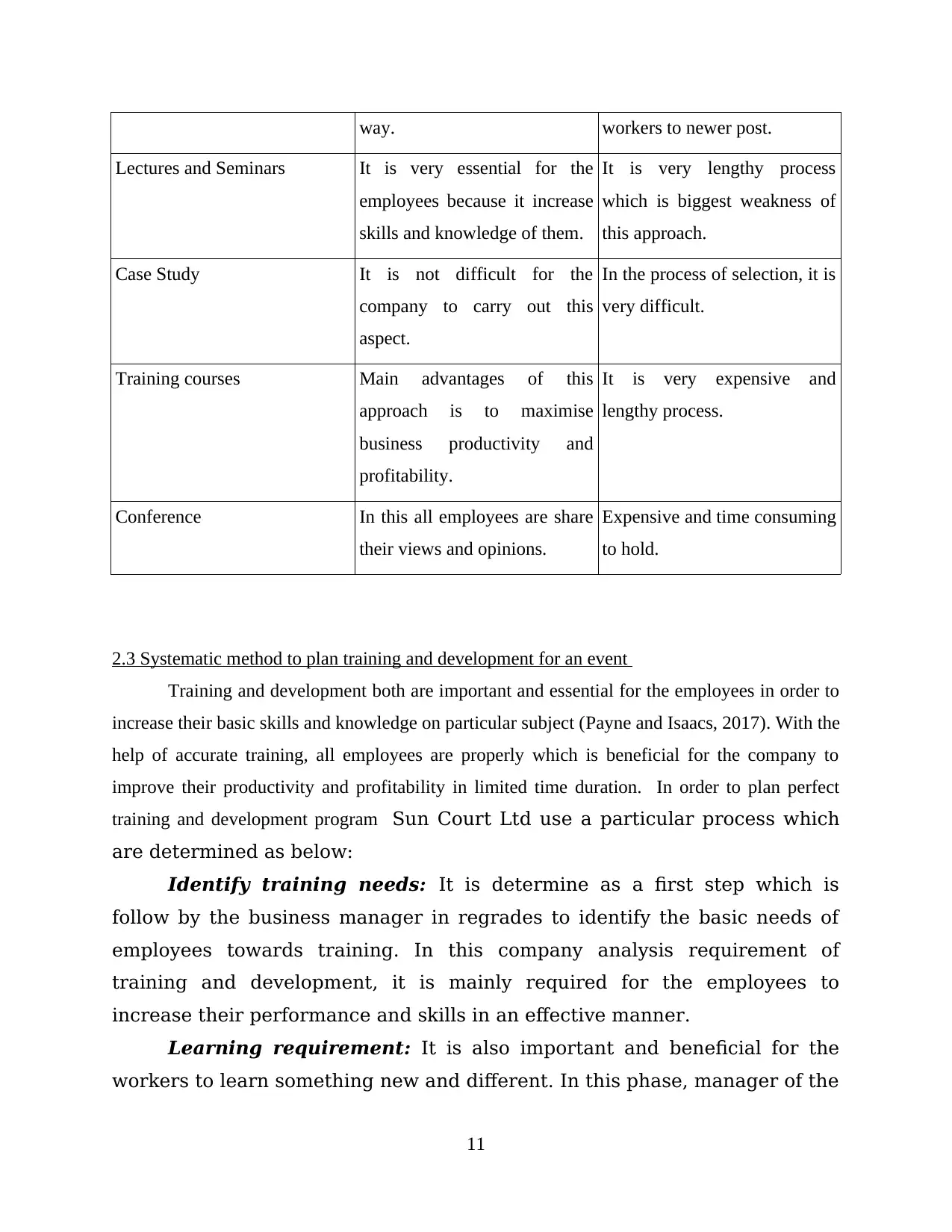
way. workers to newer post.
Lectures and Seminars It is very essential for the
employees because it increase
skills and knowledge of them.
It is very lengthy process
which is biggest weakness of
this approach.
Case Study It is not difficult for the
company to carry out this
aspect.
In the process of selection, it is
very difficult.
Training courses Main advantages of this
approach is to maximise
business productivity and
profitability.
It is very expensive and
lengthy process.
Conference In this all employees are share
their views and opinions.
Expensive and time consuming
to hold.
2.3 Systematic method to plan training and development for an event
Training and development both are important and essential for the employees in order to
increase their basic skills and knowledge on particular subject (Payne and Isaacs, 2017). With the
help of accurate training, all employees are properly which is beneficial for the company to
improve their productivity and profitability in limited time duration. In order to plan perfect
training and development program Sun Court Ltd use a particular process which
are determined as below:
Identify training needs: It is determine as a first step which is
follow by the business manager in regrades to identify the basic needs of
employees towards training. In this company analysis requirement of
training and development, it is mainly required for the employees to
increase their performance and skills in an effective manner.
Learning requirement: It is also important and beneficial for the
workers to learn something new and different. In this phase, manager of the
11
Lectures and Seminars It is very essential for the
employees because it increase
skills and knowledge of them.
It is very lengthy process
which is biggest weakness of
this approach.
Case Study It is not difficult for the
company to carry out this
aspect.
In the process of selection, it is
very difficult.
Training courses Main advantages of this
approach is to maximise
business productivity and
profitability.
It is very expensive and
lengthy process.
Conference In this all employees are share
their views and opinions.
Expensive and time consuming
to hold.
2.3 Systematic method to plan training and development for an event
Training and development both are important and essential for the employees in order to
increase their basic skills and knowledge on particular subject (Payne and Isaacs, 2017). With the
help of accurate training, all employees are properly which is beneficial for the company to
improve their productivity and profitability in limited time duration. In order to plan perfect
training and development program Sun Court Ltd use a particular process which
are determined as below:
Identify training needs: It is determine as a first step which is
follow by the business manager in regrades to identify the basic needs of
employees towards training. In this company analysis requirement of
training and development, it is mainly required for the employees to
increase their performance and skills in an effective manner.
Learning requirement: It is also important and beneficial for the
workers to learn something new and different. In this phase, manager of the
11
Paraphrase This Document
Need a fresh take? Get an instant paraphrase of this document with our AI Paraphraser
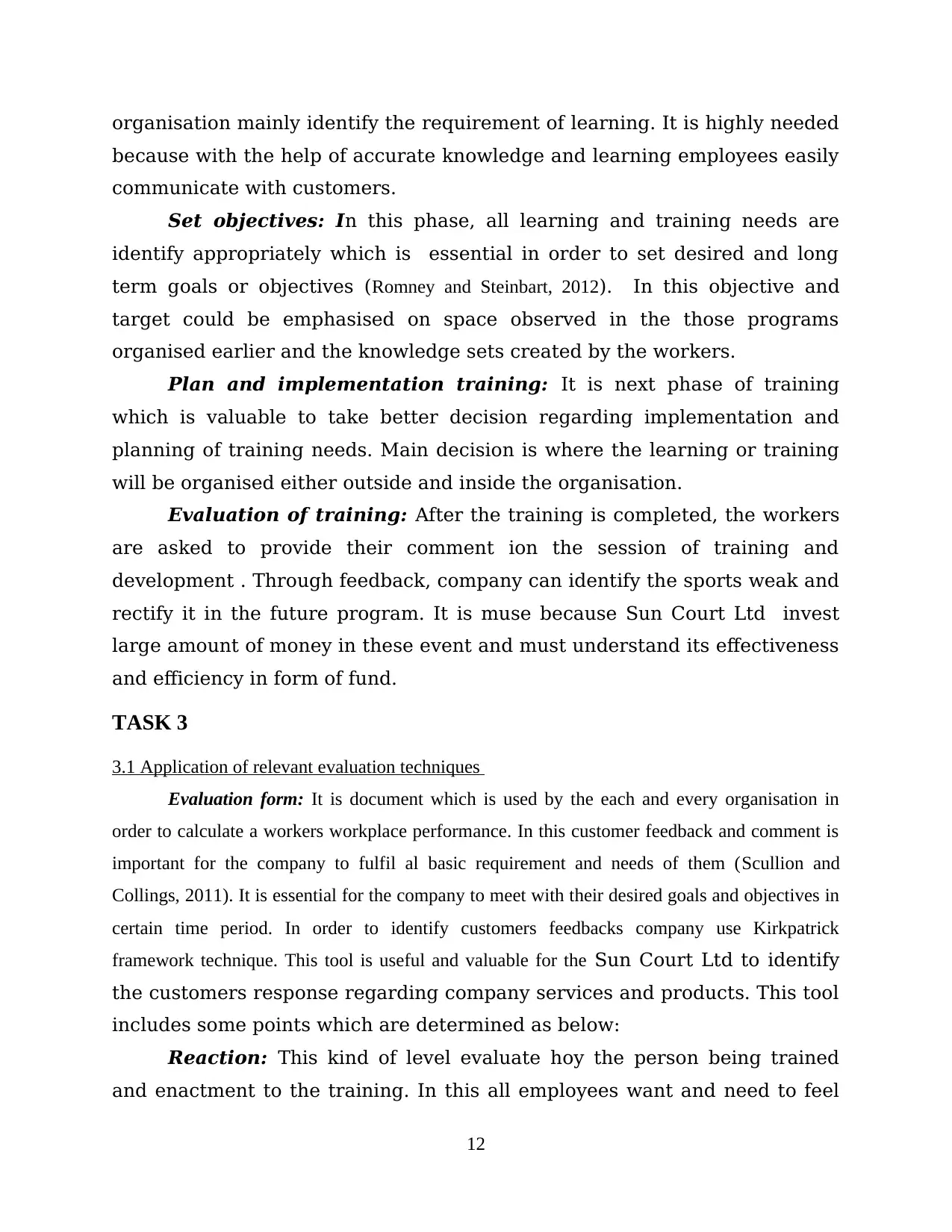
organisation mainly identify the requirement of learning. It is highly needed
because with the help of accurate knowledge and learning employees easily
communicate with customers.
Set objectives: In this phase, all learning and training needs are
identify appropriately which is essential in order to set desired and long
term goals or objectives (Romney and Steinbart, 2012). In this objective and
target could be emphasised on space observed in the those programs
organised earlier and the knowledge sets created by the workers.
Plan and implementation training: It is next phase of training
which is valuable to take better decision regarding implementation and
planning of training needs. Main decision is where the learning or training
will be organised either outside and inside the organisation.
Evaluation of training: After the training is completed, the workers
are asked to provide their comment ion the session of training and
development . Through feedback, company can identify the sports weak and
rectify it in the future program. It is muse because Sun Court Ltd invest
large amount of money in these event and must understand its effectiveness
and efficiency in form of fund.
TASK 3
3.1 Application of relevant evaluation techniques
Evaluation form: It is document which is used by the each and every organisation in
order to calculate a workers workplace performance. In this customer feedback and comment is
important for the company to fulfil al basic requirement and needs of them (Scullion and
Collings, 2011). It is essential for the company to meet with their desired goals and objectives in
certain time period. In order to identify customers feedbacks company use Kirkpatrick
framework technique. This tool is useful and valuable for the Sun Court Ltd to identify
the customers response regarding company services and products. This tool
includes some points which are determined as below:
Reaction: This kind of level evaluate hoy the person being trained
and enactment to the training. In this all employees want and need to feel
12
because with the help of accurate knowledge and learning employees easily
communicate with customers.
Set objectives: In this phase, all learning and training needs are
identify appropriately which is essential in order to set desired and long
term goals or objectives (Romney and Steinbart, 2012). In this objective and
target could be emphasised on space observed in the those programs
organised earlier and the knowledge sets created by the workers.
Plan and implementation training: It is next phase of training
which is valuable to take better decision regarding implementation and
planning of training needs. Main decision is where the learning or training
will be organised either outside and inside the organisation.
Evaluation of training: After the training is completed, the workers
are asked to provide their comment ion the session of training and
development . Through feedback, company can identify the sports weak and
rectify it in the future program. It is muse because Sun Court Ltd invest
large amount of money in these event and must understand its effectiveness
and efficiency in form of fund.
TASK 3
3.1 Application of relevant evaluation techniques
Evaluation form: It is document which is used by the each and every organisation in
order to calculate a workers workplace performance. In this customer feedback and comment is
important for the company to fulfil al basic requirement and needs of them (Scullion and
Collings, 2011). It is essential for the company to meet with their desired goals and objectives in
certain time period. In order to identify customers feedbacks company use Kirkpatrick
framework technique. This tool is useful and valuable for the Sun Court Ltd to identify
the customers response regarding company services and products. This tool
includes some points which are determined as below:
Reaction: This kind of level evaluate hoy the person being trained
and enactment to the training. In this all employees want and need to feel
12
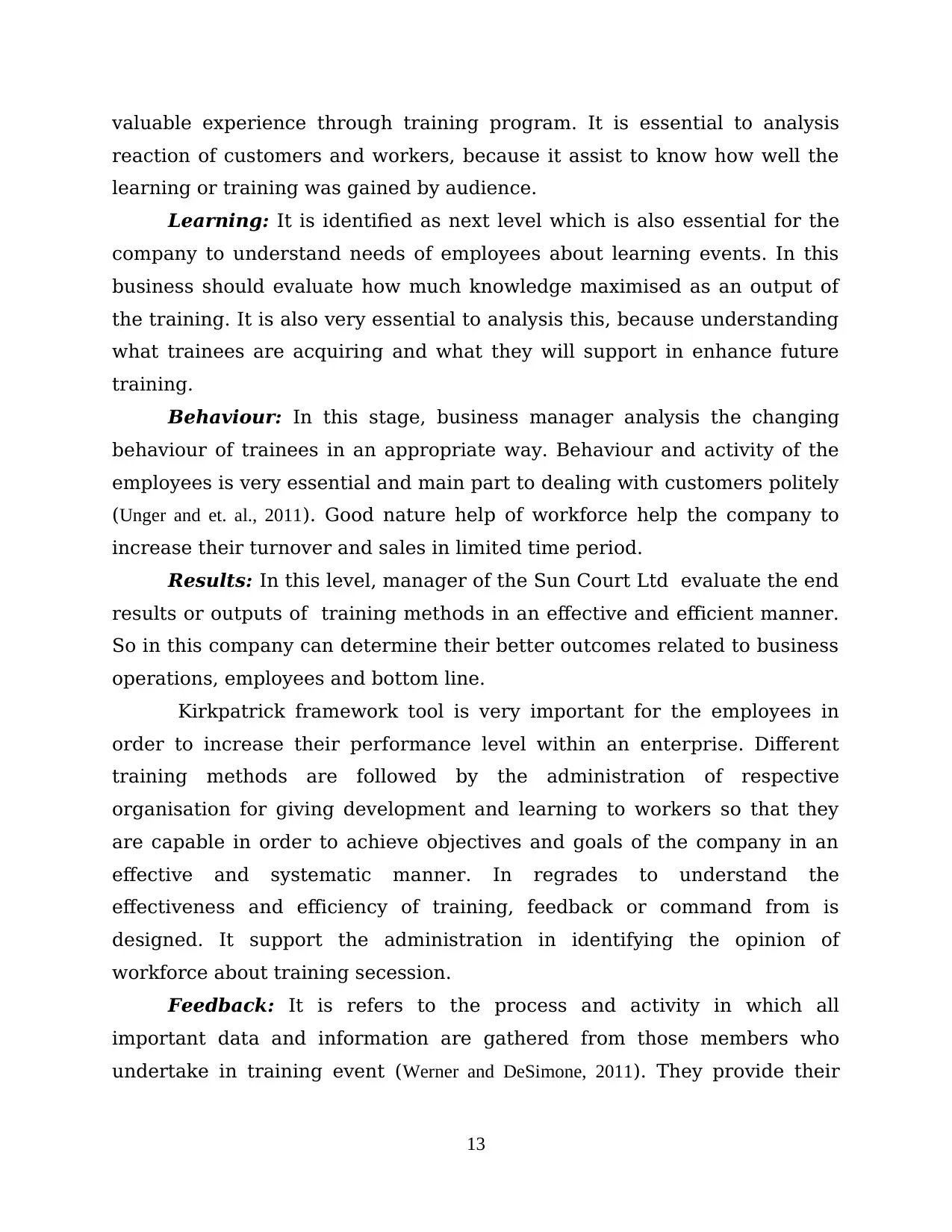
valuable experience through training program. It is essential to analysis
reaction of customers and workers, because it assist to know how well the
learning or training was gained by audience.
Learning: It is identified as next level which is also essential for the
company to understand needs of employees about learning events. In this
business should evaluate how much knowledge maximised as an output of
the training. It is also very essential to analysis this, because understanding
what trainees are acquiring and what they will support in enhance future
training.
Behaviour: In this stage, business manager analysis the changing
behaviour of trainees in an appropriate way. Behaviour and activity of the
employees is very essential and main part to dealing with customers politely
(Unger and et. al., 2011). Good nature help of workforce help the company to
increase their turnover and sales in limited time period.
Results: In this level, manager of the Sun Court Ltd evaluate the end
results or outputs of training methods in an effective and efficient manner.
So in this company can determine their better outcomes related to business
operations, employees and bottom line.
Kirkpatrick framework tool is very important for the employees in
order to increase their performance level within an enterprise. Different
training methods are followed by the administration of respective
organisation for giving development and learning to workers so that they
are capable in order to achieve objectives and goals of the company in an
effective and systematic manner. In regrades to understand the
effectiveness and efficiency of training, feedback or command from is
designed. It support the administration in identifying the opinion of
workforce about training secession.
Feedback: It is refers to the process and activity in which all
important data and information are gathered from those members who
undertake in training event (Werner and DeSimone, 2011). They provide their
13
reaction of customers and workers, because it assist to know how well the
learning or training was gained by audience.
Learning: It is identified as next level which is also essential for the
company to understand needs of employees about learning events. In this
business should evaluate how much knowledge maximised as an output of
the training. It is also very essential to analysis this, because understanding
what trainees are acquiring and what they will support in enhance future
training.
Behaviour: In this stage, business manager analysis the changing
behaviour of trainees in an appropriate way. Behaviour and activity of the
employees is very essential and main part to dealing with customers politely
(Unger and et. al., 2011). Good nature help of workforce help the company to
increase their turnover and sales in limited time period.
Results: In this level, manager of the Sun Court Ltd evaluate the end
results or outputs of training methods in an effective and efficient manner.
So in this company can determine their better outcomes related to business
operations, employees and bottom line.
Kirkpatrick framework tool is very important for the employees in
order to increase their performance level within an enterprise. Different
training methods are followed by the administration of respective
organisation for giving development and learning to workers so that they
are capable in order to achieve objectives and goals of the company in an
effective and systematic manner. In regrades to understand the
effectiveness and efficiency of training, feedback or command from is
designed. It support the administration in identifying the opinion of
workforce about training secession.
Feedback: It is refers to the process and activity in which all
important data and information are gathered from those members who
undertake in training event (Werner and DeSimone, 2011). They provide their
13
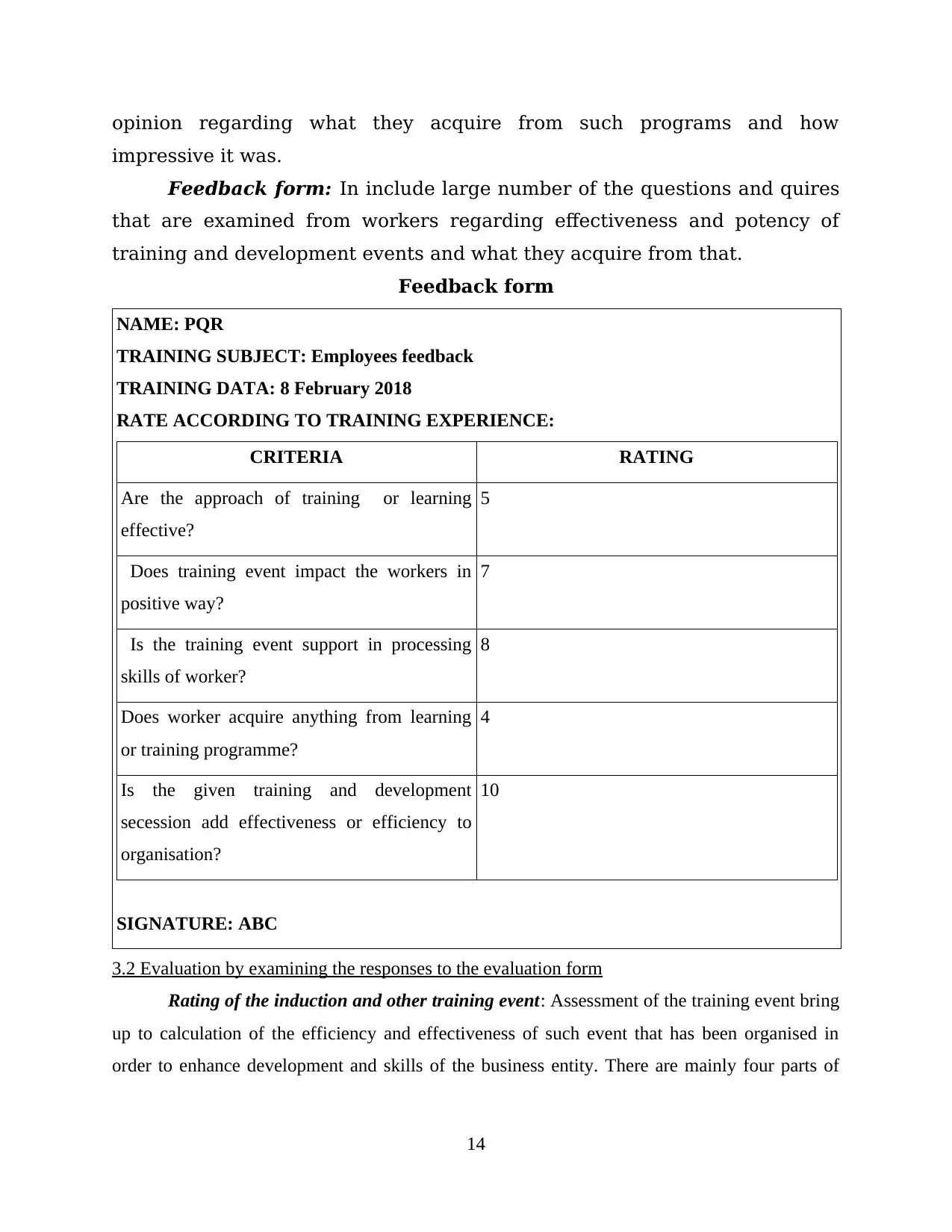
opinion regarding what they acquire from such programs and how
impressive it was.
Feedback form: In include large number of the questions and quires
that are examined from workers regarding effectiveness and potency of
training and development events and what they acquire from that.
Feedback form
NAME: PQR
TRAINING SUBJECT: Employees feedback
TRAINING DATA: 8 February 2018
RATE ACCORDING TO TRAINING EXPERIENCE:
CRITERIA RATING
Are the approach of training or learning
effective?
5
Does training event impact the workers in
positive way?
7
Is the training event support in processing
skills of worker?
8
Does worker acquire anything from learning
or training programme?
4
Is the given training and development
secession add effectiveness or efficiency to
organisation?
10
SIGNATURE: ABC
3.2 Evaluation by examining the responses to the evaluation form
Rating of the induction and other training event: Assessment of the training event bring
up to calculation of the efficiency and effectiveness of such event that has been organised in
order to enhance development and skills of the business entity. There are mainly four parts of
14
impressive it was.
Feedback form: In include large number of the questions and quires
that are examined from workers regarding effectiveness and potency of
training and development events and what they acquire from that.
Feedback form
NAME: PQR
TRAINING SUBJECT: Employees feedback
TRAINING DATA: 8 February 2018
RATE ACCORDING TO TRAINING EXPERIENCE:
CRITERIA RATING
Are the approach of training or learning
effective?
5
Does training event impact the workers in
positive way?
7
Is the training event support in processing
skills of worker?
8
Does worker acquire anything from learning
or training programme?
4
Is the given training and development
secession add effectiveness or efficiency to
organisation?
10
SIGNATURE: ABC
3.2 Evaluation by examining the responses to the evaluation form
Rating of the induction and other training event: Assessment of the training event bring
up to calculation of the efficiency and effectiveness of such event that has been organised in
order to enhance development and skills of the business entity. There are mainly four parts of
14
Secure Best Marks with AI Grader
Need help grading? Try our AI Grader for instant feedback on your assignments.
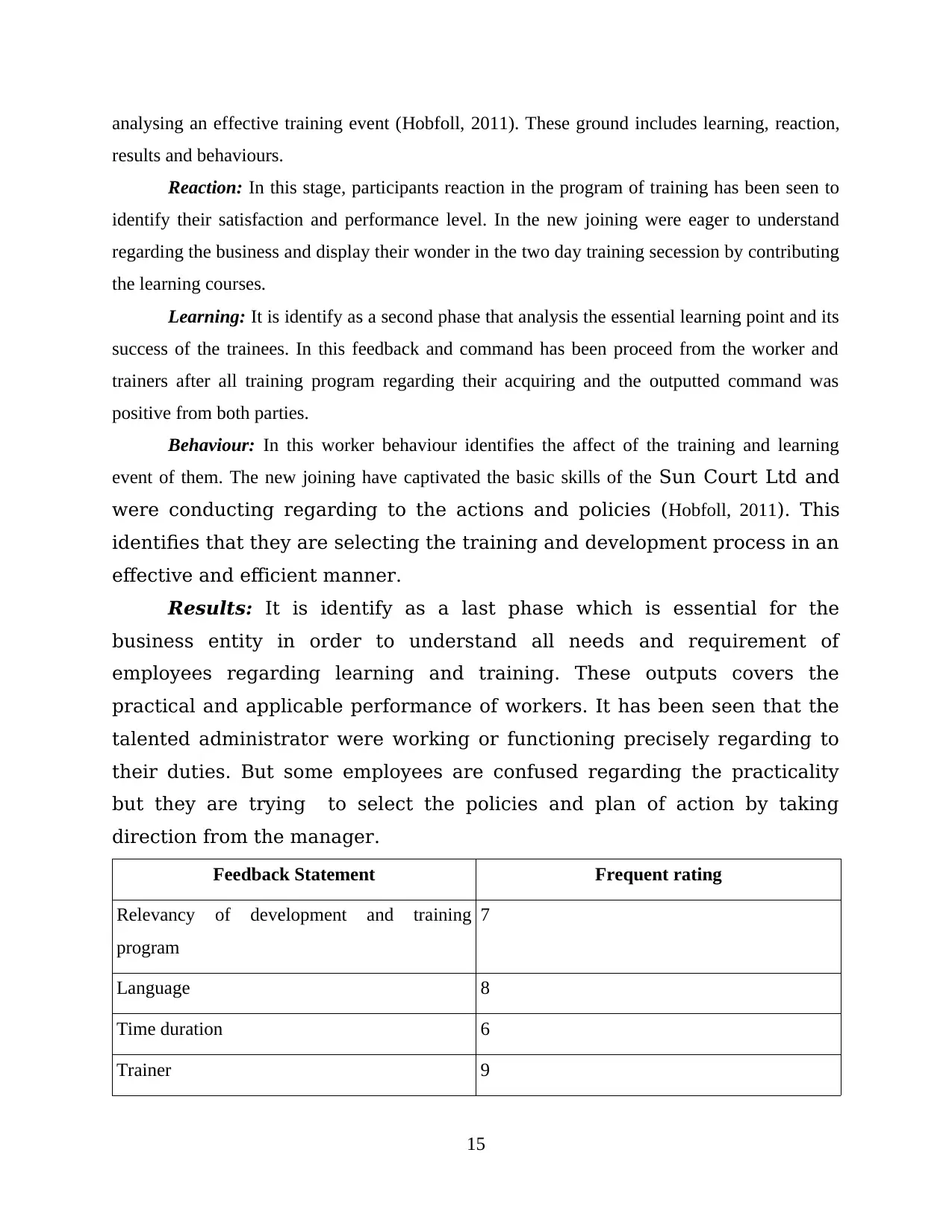
analysing an effective training event (Hobfoll, 2011). These ground includes learning, reaction,
results and behaviours.
Reaction: In this stage, participants reaction in the program of training has been seen to
identify their satisfaction and performance level. In the new joining were eager to understand
regarding the business and display their wonder in the two day training secession by contributing
the learning courses.
Learning: It is identify as a second phase that analysis the essential learning point and its
success of the trainees. In this feedback and command has been proceed from the worker and
trainers after all training program regarding their acquiring and the outputted command was
positive from both parties.
Behaviour: In this worker behaviour identifies the affect of the training and learning
event of them. The new joining have captivated the basic skills of the Sun Court Ltd and
were conducting regarding to the actions and policies (Hobfoll, 2011). This
identifies that they are selecting the training and development process in an
effective and efficient manner.
Results: It is identify as a last phase which is essential for the
business entity in order to understand all needs and requirement of
employees regarding learning and training. These outputs covers the
practical and applicable performance of workers. It has been seen that the
talented administrator were working or functioning precisely regarding to
their duties. But some employees are confused regarding the practicality
but they are trying to select the policies and plan of action by taking
direction from the manager.
Feedback Statement Frequent rating
Relevancy of development and training
program
7
Language 8
Time duration 6
Trainer 9
15
results and behaviours.
Reaction: In this stage, participants reaction in the program of training has been seen to
identify their satisfaction and performance level. In the new joining were eager to understand
regarding the business and display their wonder in the two day training secession by contributing
the learning courses.
Learning: It is identify as a second phase that analysis the essential learning point and its
success of the trainees. In this feedback and command has been proceed from the worker and
trainers after all training program regarding their acquiring and the outputted command was
positive from both parties.
Behaviour: In this worker behaviour identifies the affect of the training and learning
event of them. The new joining have captivated the basic skills of the Sun Court Ltd and
were conducting regarding to the actions and policies (Hobfoll, 2011). This
identifies that they are selecting the training and development process in an
effective and efficient manner.
Results: It is identify as a last phase which is essential for the
business entity in order to understand all needs and requirement of
employees regarding learning and training. These outputs covers the
practical and applicable performance of workers. It has been seen that the
talented administrator were working or functioning precisely regarding to
their duties. But some employees are confused regarding the practicality
but they are trying to select the policies and plan of action by taking
direction from the manager.
Feedback Statement Frequent rating
Relevancy of development and training
program
7
Language 8
Time duration 6
Trainer 9
15
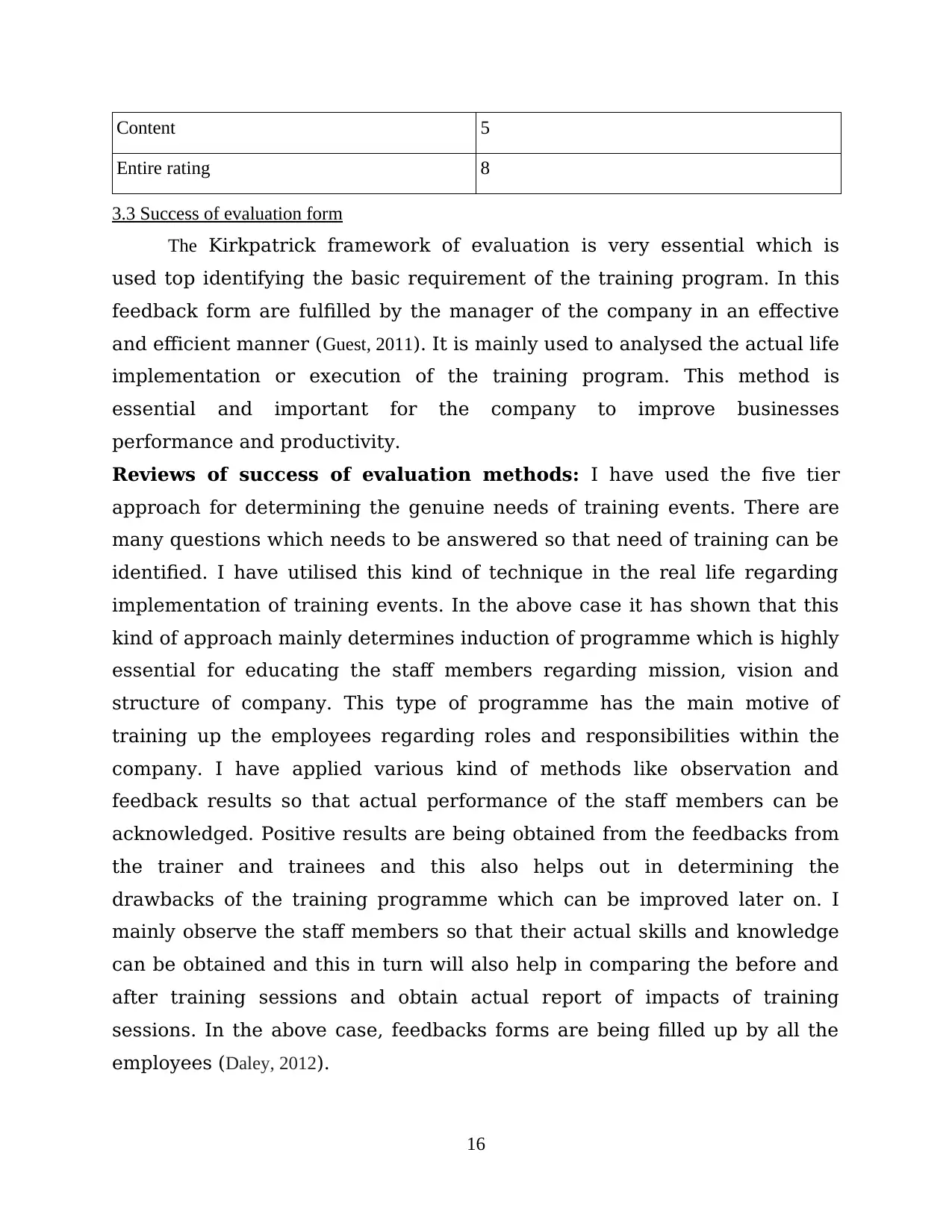
Content 5
Entire rating 8
3.3 Success of evaluation form
The Kirkpatrick framework of evaluation is very essential which is
used top identifying the basic requirement of the training program. In this
feedback form are fulfilled by the manager of the company in an effective
and efficient manner (Guest, 2011). It is mainly used to analysed the actual life
implementation or execution of the training program. This method is
essential and important for the company to improve businesses
performance and productivity.
Reviews of success of evaluation methods: I have used the five tier
approach for determining the genuine needs of training events. There are
many questions which needs to be answered so that need of training can be
identified. I have utilised this kind of technique in the real life regarding
implementation of training events. In the above case it has shown that this
kind of approach mainly determines induction of programme which is highly
essential for educating the staff members regarding mission, vision and
structure of company. This type of programme has the main motive of
training up the employees regarding roles and responsibilities within the
company. I have applied various kind of methods like observation and
feedback results so that actual performance of the staff members can be
acknowledged. Positive results are being obtained from the feedbacks from
the trainer and trainees and this also helps out in determining the
drawbacks of the training programme which can be improved later on. I
mainly observe the staff members so that their actual skills and knowledge
can be obtained and this in turn will also help in comparing the before and
after training sessions and obtain actual report of impacts of training
sessions. In the above case, feedbacks forms are being filled up by all the
employees (Daley, 2012).
16
Entire rating 8
3.3 Success of evaluation form
The Kirkpatrick framework of evaluation is very essential which is
used top identifying the basic requirement of the training program. In this
feedback form are fulfilled by the manager of the company in an effective
and efficient manner (Guest, 2011). It is mainly used to analysed the actual life
implementation or execution of the training program. This method is
essential and important for the company to improve businesses
performance and productivity.
Reviews of success of evaluation methods: I have used the five tier
approach for determining the genuine needs of training events. There are
many questions which needs to be answered so that need of training can be
identified. I have utilised this kind of technique in the real life regarding
implementation of training events. In the above case it has shown that this
kind of approach mainly determines induction of programme which is highly
essential for educating the staff members regarding mission, vision and
structure of company. This type of programme has the main motive of
training up the employees regarding roles and responsibilities within the
company. I have applied various kind of methods like observation and
feedback results so that actual performance of the staff members can be
acknowledged. Positive results are being obtained from the feedbacks from
the trainer and trainees and this also helps out in determining the
drawbacks of the training programme which can be improved later on. I
mainly observe the staff members so that their actual skills and knowledge
can be obtained and this in turn will also help in comparing the before and
after training sessions and obtain actual report of impacts of training
sessions. In the above case, feedbacks forms are being filled up by all the
employees (Daley, 2012).
16
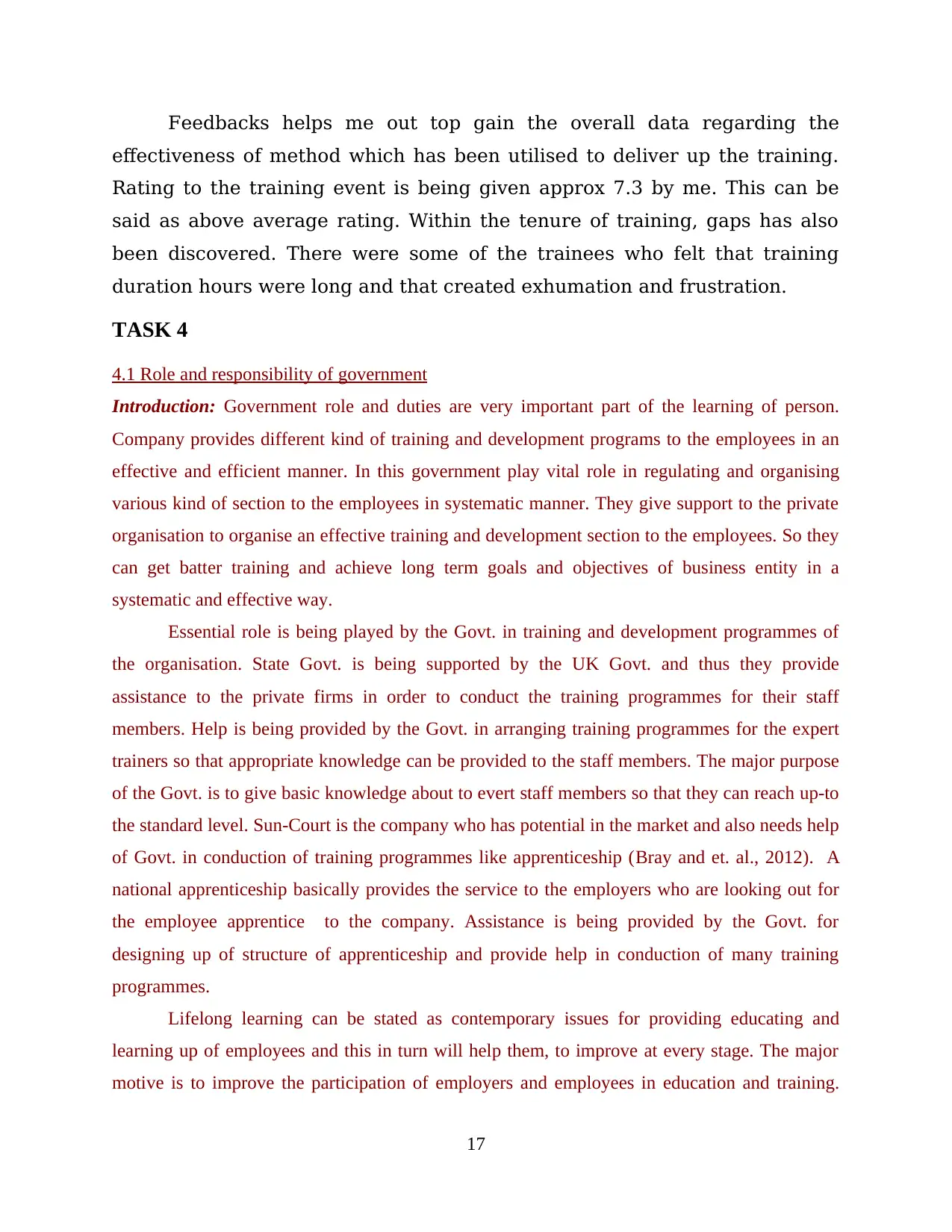
Feedbacks helps me out top gain the overall data regarding the
effectiveness of method which has been utilised to deliver up the training.
Rating to the training event is being given approx 7.3 by me. This can be
said as above average rating. Within the tenure of training, gaps has also
been discovered. There were some of the trainees who felt that training
duration hours were long and that created exhumation and frustration.
TASK 4
4.1 Role and responsibility of government
Introduction: Government role and duties are very important part of the learning of person.
Company provides different kind of training and development programs to the employees in an
effective and efficient manner. In this government play vital role in regulating and organising
various kind of section to the employees in systematic manner. They give support to the private
organisation to organise an effective training and development section to the employees. So they
can get batter training and achieve long term goals and objectives of business entity in a
systematic and effective way.
Essential role is being played by the Govt. in training and development programmes of
the organisation. State Govt. is being supported by the UK Govt. and thus they provide
assistance to the private firms in order to conduct the training programmes for their staff
members. Help is being provided by the Govt. in arranging training programmes for the expert
trainers so that appropriate knowledge can be provided to the staff members. The major purpose
of the Govt. is to give basic knowledge about to evert staff members so that they can reach up-to
the standard level. Sun-Court is the company who has potential in the market and also needs help
of Govt. in conduction of training programmes like apprenticeship (Bray and et. al., 2012). A
national apprenticeship basically provides the service to the employers who are looking out for
the employee apprentice to the company. Assistance is being provided by the Govt. for
designing up of structure of apprenticeship and provide help in conduction of many training
programmes.
Lifelong learning can be stated as contemporary issues for providing educating and
learning up of employees and this in turn will help them, to improve at every stage. The major
motive is to improve the participation of employers and employees in education and training.
17
effectiveness of method which has been utilised to deliver up the training.
Rating to the training event is being given approx 7.3 by me. This can be
said as above average rating. Within the tenure of training, gaps has also
been discovered. There were some of the trainees who felt that training
duration hours were long and that created exhumation and frustration.
TASK 4
4.1 Role and responsibility of government
Introduction: Government role and duties are very important part of the learning of person.
Company provides different kind of training and development programs to the employees in an
effective and efficient manner. In this government play vital role in regulating and organising
various kind of section to the employees in systematic manner. They give support to the private
organisation to organise an effective training and development section to the employees. So they
can get batter training and achieve long term goals and objectives of business entity in a
systematic and effective way.
Essential role is being played by the Govt. in training and development programmes of
the organisation. State Govt. is being supported by the UK Govt. and thus they provide
assistance to the private firms in order to conduct the training programmes for their staff
members. Help is being provided by the Govt. in arranging training programmes for the expert
trainers so that appropriate knowledge can be provided to the staff members. The major purpose
of the Govt. is to give basic knowledge about to evert staff members so that they can reach up-to
the standard level. Sun-Court is the company who has potential in the market and also needs help
of Govt. in conduction of training programmes like apprenticeship (Bray and et. al., 2012). A
national apprenticeship basically provides the service to the employers who are looking out for
the employee apprentice to the company. Assistance is being provided by the Govt. for
designing up of structure of apprenticeship and provide help in conduction of many training
programmes.
Lifelong learning can be stated as contemporary issues for providing educating and
learning up of employees and this in turn will help them, to improve at every stage. The major
motive is to improve the participation of employers and employees in education and training.
17
Paraphrase This Document
Need a fresh take? Get an instant paraphrase of this document with our AI Paraphraser

This is the reason behind in enhancement of all the employers and employees in education and
training. This is mainly responsible for professional development of all the working people in
communities, higher education, libraries and work based learning across the UK. Lifelong
learning UK ceased to operate as Sector Skills Council on 31st March 2011. They has few
strategic goals and objectives such as:
To promote the administrator for maximum investment in training program.
To offer respected as well as credible labour marketplace to the workers.
To Create relevant skills and learning solutions. In order to improve the learning events quality in an effective manner.
Conclusion: From the above information that can be concluded that roles and responsibilities of
government is very essential and beneficial part. With the help of rules and regulation company
easily provide accurate training to the workers. So all are work with achieving long lasting
benefits and advantages of an organisation. In this business role in to develop learning solutions
and events in a systematic manner.
4.2 Development of the competence movement has effected private and public organisation
Introduction: Development is important and main part of the business success and growth.
Competence movement has impacted on both organisations such as public and private in an
effective way. Sun-Court is a United Kingdom organisation which want to evaluate core
competency of company along with competencies and skills.
In order to measure the whole job performance of employees and business, there are
different performance management events that create both private and public sectors. It will
assist in analysing entire skills and power of workers at the period of achieving task (Bamberger,
Biron and Meshoulam, 2014). In this employees of the company clearly communicate with the
customers in an effective and efficient manner. Private business analysis to be munch impacted
by this change as they were investigating more regarding this business and utilising the
calculation in order to accomplish the competitive and long term benefits in an effective manner.
They analysis that tumble in the employees performance which output in deficient production,
poor quality of services and many other.
In development of HRM, public sector organisation gives their maximum involvement in
the business entity. In the organisation human resource mainly focuses on increasing the
18
training. This is mainly responsible for professional development of all the working people in
communities, higher education, libraries and work based learning across the UK. Lifelong
learning UK ceased to operate as Sector Skills Council on 31st March 2011. They has few
strategic goals and objectives such as:
To promote the administrator for maximum investment in training program.
To offer respected as well as credible labour marketplace to the workers.
To Create relevant skills and learning solutions. In order to improve the learning events quality in an effective manner.
Conclusion: From the above information that can be concluded that roles and responsibilities of
government is very essential and beneficial part. With the help of rules and regulation company
easily provide accurate training to the workers. So all are work with achieving long lasting
benefits and advantages of an organisation. In this business role in to develop learning solutions
and events in a systematic manner.
4.2 Development of the competence movement has effected private and public organisation
Introduction: Development is important and main part of the business success and growth.
Competence movement has impacted on both organisations such as public and private in an
effective way. Sun-Court is a United Kingdom organisation which want to evaluate core
competency of company along with competencies and skills.
In order to measure the whole job performance of employees and business, there are
different performance management events that create both private and public sectors. It will
assist in analysing entire skills and power of workers at the period of achieving task (Bamberger,
Biron and Meshoulam, 2014). In this employees of the company clearly communicate with the
customers in an effective and efficient manner. Private business analysis to be munch impacted
by this change as they were investigating more regarding this business and utilising the
calculation in order to accomplish the competitive and long term benefits in an effective manner.
They analysis that tumble in the employees performance which output in deficient production,
poor quality of services and many other.
In development of HRM, public sector organisation gives their maximum involvement in
the business entity. In the organisation human resource mainly focuses on increasing the
18
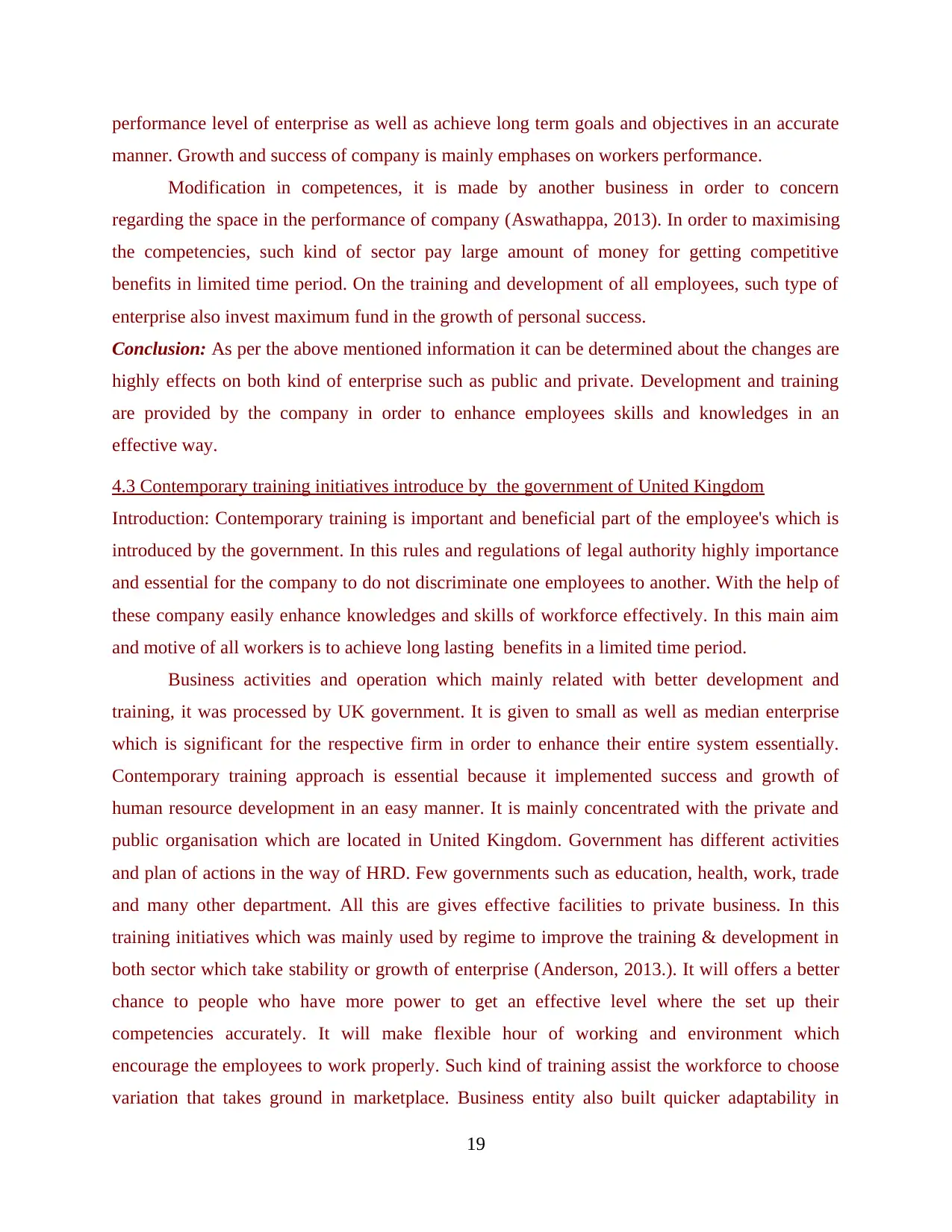
performance level of enterprise as well as achieve long term goals and objectives in an accurate
manner. Growth and success of company is mainly emphases on workers performance.
Modification in competences, it is made by another business in order to concern
regarding the space in the performance of company (Aswathappa, 2013). In order to maximising
the competencies, such kind of sector pay large amount of money for getting competitive
benefits in limited time period. On the training and development of all employees, such type of
enterprise also invest maximum fund in the growth of personal success.
Conclusion: As per the above mentioned information it can be determined about the changes are
highly effects on both kind of enterprise such as public and private. Development and training
are provided by the company in order to enhance employees skills and knowledges in an
effective way.
4.3 Contemporary training initiatives introduce by the government of United Kingdom
Introduction: Contemporary training is important and beneficial part of the employee's which is
introduced by the government. In this rules and regulations of legal authority highly importance
and essential for the company to do not discriminate one employees to another. With the help of
these company easily enhance knowledges and skills of workforce effectively. In this main aim
and motive of all workers is to achieve long lasting benefits in a limited time period.
Business activities and operation which mainly related with better development and
training, it was processed by UK government. It is given to small as well as median enterprise
which is significant for the respective firm in order to enhance their entire system essentially.
Contemporary training approach is essential because it implemented success and growth of
human resource development in an easy manner. It is mainly concentrated with the private and
public organisation which are located in United Kingdom. Government has different activities
and plan of actions in the way of HRD. Few governments such as education, health, work, trade
and many other department. All this are gives effective facilities to private business. In this
training initiatives which was mainly used by regime to improve the training & development in
both sector which take stability or growth of enterprise (Anderson, 2013.). It will offers a better
chance to people who have more power to get an effective level where the set up their
competencies accurately. It will make flexible hour of working and environment which
encourage the employees to work properly. Such kind of training assist the workforce to choose
variation that takes ground in marketplace. Business entity also built quicker adaptability in
19
manner. Growth and success of company is mainly emphases on workers performance.
Modification in competences, it is made by another business in order to concern
regarding the space in the performance of company (Aswathappa, 2013). In order to maximising
the competencies, such kind of sector pay large amount of money for getting competitive
benefits in limited time period. On the training and development of all employees, such type of
enterprise also invest maximum fund in the growth of personal success.
Conclusion: As per the above mentioned information it can be determined about the changes are
highly effects on both kind of enterprise such as public and private. Development and training
are provided by the company in order to enhance employees skills and knowledges in an
effective way.
4.3 Contemporary training initiatives introduce by the government of United Kingdom
Introduction: Contemporary training is important and beneficial part of the employee's which is
introduced by the government. In this rules and regulations of legal authority highly importance
and essential for the company to do not discriminate one employees to another. With the help of
these company easily enhance knowledges and skills of workforce effectively. In this main aim
and motive of all workers is to achieve long lasting benefits in a limited time period.
Business activities and operation which mainly related with better development and
training, it was processed by UK government. It is given to small as well as median enterprise
which is significant for the respective firm in order to enhance their entire system essentially.
Contemporary training approach is essential because it implemented success and growth of
human resource development in an easy manner. It is mainly concentrated with the private and
public organisation which are located in United Kingdom. Government has different activities
and plan of actions in the way of HRD. Few governments such as education, health, work, trade
and many other department. All this are gives effective facilities to private business. In this
training initiatives which was mainly used by regime to improve the training & development in
both sector which take stability or growth of enterprise (Anderson, 2013.). It will offers a better
chance to people who have more power to get an effective level where the set up their
competencies accurately. It will make flexible hour of working and environment which
encourage the employees to work properly. Such kind of training assist the workforce to choose
variation that takes ground in marketplace. Business entity also built quicker adaptability in
19
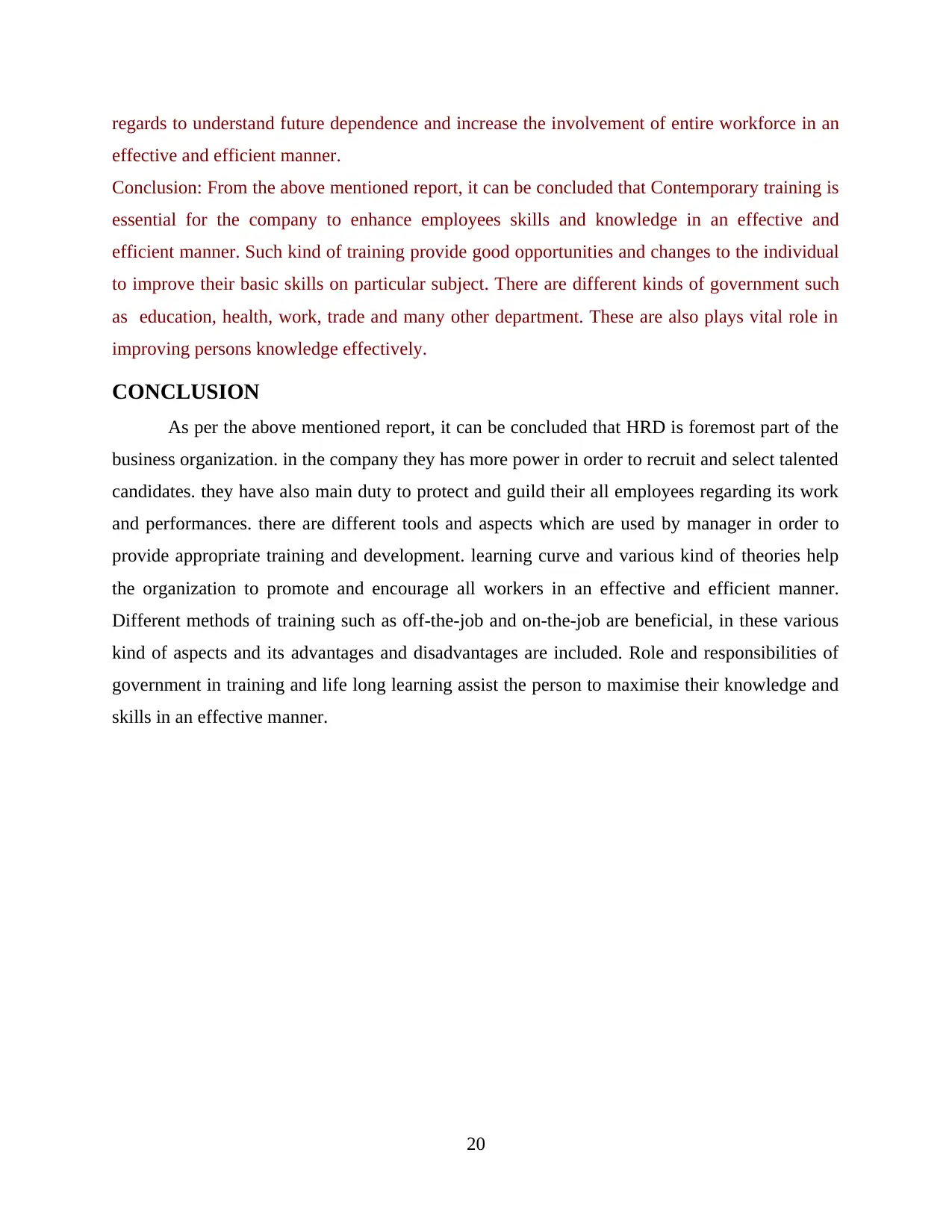
regards to understand future dependence and increase the involvement of entire workforce in an
effective and efficient manner.
Conclusion: From the above mentioned report, it can be concluded that Contemporary training is
essential for the company to enhance employees skills and knowledge in an effective and
efficient manner. Such kind of training provide good opportunities and changes to the individual
to improve their basic skills on particular subject. There are different kinds of government such
as education, health, work, trade and many other department. These are also plays vital role in
improving persons knowledge effectively.
CONCLUSION
As per the above mentioned report, it can be concluded that HRD is foremost part of the
business organization. in the company they has more power in order to recruit and select talented
candidates. they have also main duty to protect and guild their all employees regarding its work
and performances. there are different tools and aspects which are used by manager in order to
provide appropriate training and development. learning curve and various kind of theories help
the organization to promote and encourage all workers in an effective and efficient manner.
Different methods of training such as off-the-job and on-the-job are beneficial, in these various
kind of aspects and its advantages and disadvantages are included. Role and responsibilities of
government in training and life long learning assist the person to maximise their knowledge and
skills in an effective manner.
20
effective and efficient manner.
Conclusion: From the above mentioned report, it can be concluded that Contemporary training is
essential for the company to enhance employees skills and knowledge in an effective and
efficient manner. Such kind of training provide good opportunities and changes to the individual
to improve their basic skills on particular subject. There are different kinds of government such
as education, health, work, trade and many other department. These are also plays vital role in
improving persons knowledge effectively.
CONCLUSION
As per the above mentioned report, it can be concluded that HRD is foremost part of the
business organization. in the company they has more power in order to recruit and select talented
candidates. they have also main duty to protect and guild their all employees regarding its work
and performances. there are different tools and aspects which are used by manager in order to
provide appropriate training and development. learning curve and various kind of theories help
the organization to promote and encourage all workers in an effective and efficient manner.
Different methods of training such as off-the-job and on-the-job are beneficial, in these various
kind of aspects and its advantages and disadvantages are included. Role and responsibilities of
government in training and life long learning assist the person to maximise their knowledge and
skills in an effective manner.
20
Secure Best Marks with AI Grader
Need help grading? Try our AI Grader for instant feedback on your assignments.
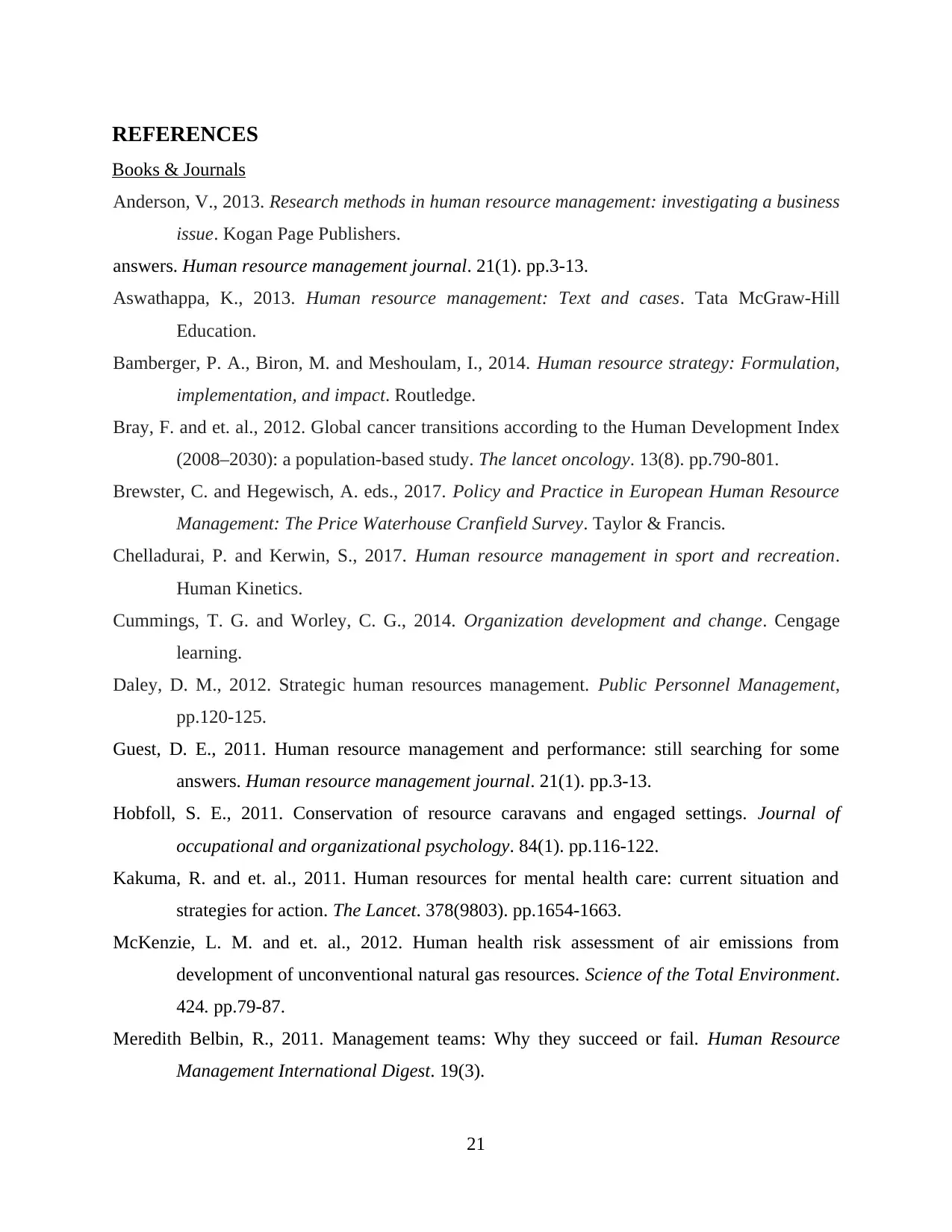
REFERENCES
Books & Journals
Anderson, V., 2013. Research methods in human resource management: investigating a business
issue. Kogan Page Publishers.
answers. Human resource management journal. 21(1). pp.3-13.
Aswathappa, K., 2013. Human resource management: Text and cases. Tata McGraw-Hill
Education.
Bamberger, P. A., Biron, M. and Meshoulam, I., 2014. Human resource strategy: Formulation,
implementation, and impact. Routledge.
Bray, F. and et. al., 2012. Global cancer transitions according to the Human Development Index
(2008–2030): a population-based study. The lancet oncology. 13(8). pp.790-801.
Brewster, C. and Hegewisch, A. eds., 2017. Policy and Practice in European Human Resource
Management: The Price Waterhouse Cranfield Survey. Taylor & Francis.
Chelladurai, P. and Kerwin, S., 2017. Human resource management in sport and recreation.
Human Kinetics.
Cummings, T. G. and Worley, C. G., 2014. Organization development and change. Cengage
learning.
Daley, D. M., 2012. Strategic human resources management. Public Personnel Management,
pp.120-125.
Guest, D. E., 2011. Human resource management and performance: still searching for some
answers. Human resource management journal. 21(1). pp.3-13.
Hobfoll, S. E., 2011. Conservation of resource caravans and engaged settings. Journal of
occupational and organizational psychology. 84(1). pp.116-122.
Kakuma, R. and et. al., 2011. Human resources for mental health care: current situation and
strategies for action. The Lancet. 378(9803). pp.1654-1663.
McKenzie, L. M. and et. al., 2012. Human health risk assessment of air emissions from
development of unconventional natural gas resources. Science of the Total Environment.
424. pp.79-87.
Meredith Belbin, R., 2011. Management teams: Why they succeed or fail. Human Resource
Management International Digest. 19(3).
21
Books & Journals
Anderson, V., 2013. Research methods in human resource management: investigating a business
issue. Kogan Page Publishers.
answers. Human resource management journal. 21(1). pp.3-13.
Aswathappa, K., 2013. Human resource management: Text and cases. Tata McGraw-Hill
Education.
Bamberger, P. A., Biron, M. and Meshoulam, I., 2014. Human resource strategy: Formulation,
implementation, and impact. Routledge.
Bray, F. and et. al., 2012. Global cancer transitions according to the Human Development Index
(2008–2030): a population-based study. The lancet oncology. 13(8). pp.790-801.
Brewster, C. and Hegewisch, A. eds., 2017. Policy and Practice in European Human Resource
Management: The Price Waterhouse Cranfield Survey. Taylor & Francis.
Chelladurai, P. and Kerwin, S., 2017. Human resource management in sport and recreation.
Human Kinetics.
Cummings, T. G. and Worley, C. G., 2014. Organization development and change. Cengage
learning.
Daley, D. M., 2012. Strategic human resources management. Public Personnel Management,
pp.120-125.
Guest, D. E., 2011. Human resource management and performance: still searching for some
answers. Human resource management journal. 21(1). pp.3-13.
Hobfoll, S. E., 2011. Conservation of resource caravans and engaged settings. Journal of
occupational and organizational psychology. 84(1). pp.116-122.
Kakuma, R. and et. al., 2011. Human resources for mental health care: current situation and
strategies for action. The Lancet. 378(9803). pp.1654-1663.
McKenzie, L. M. and et. al., 2012. Human health risk assessment of air emissions from
development of unconventional natural gas resources. Science of the Total Environment.
424. pp.79-87.
Meredith Belbin, R., 2011. Management teams: Why they succeed or fail. Human Resource
Management International Digest. 19(3).
21
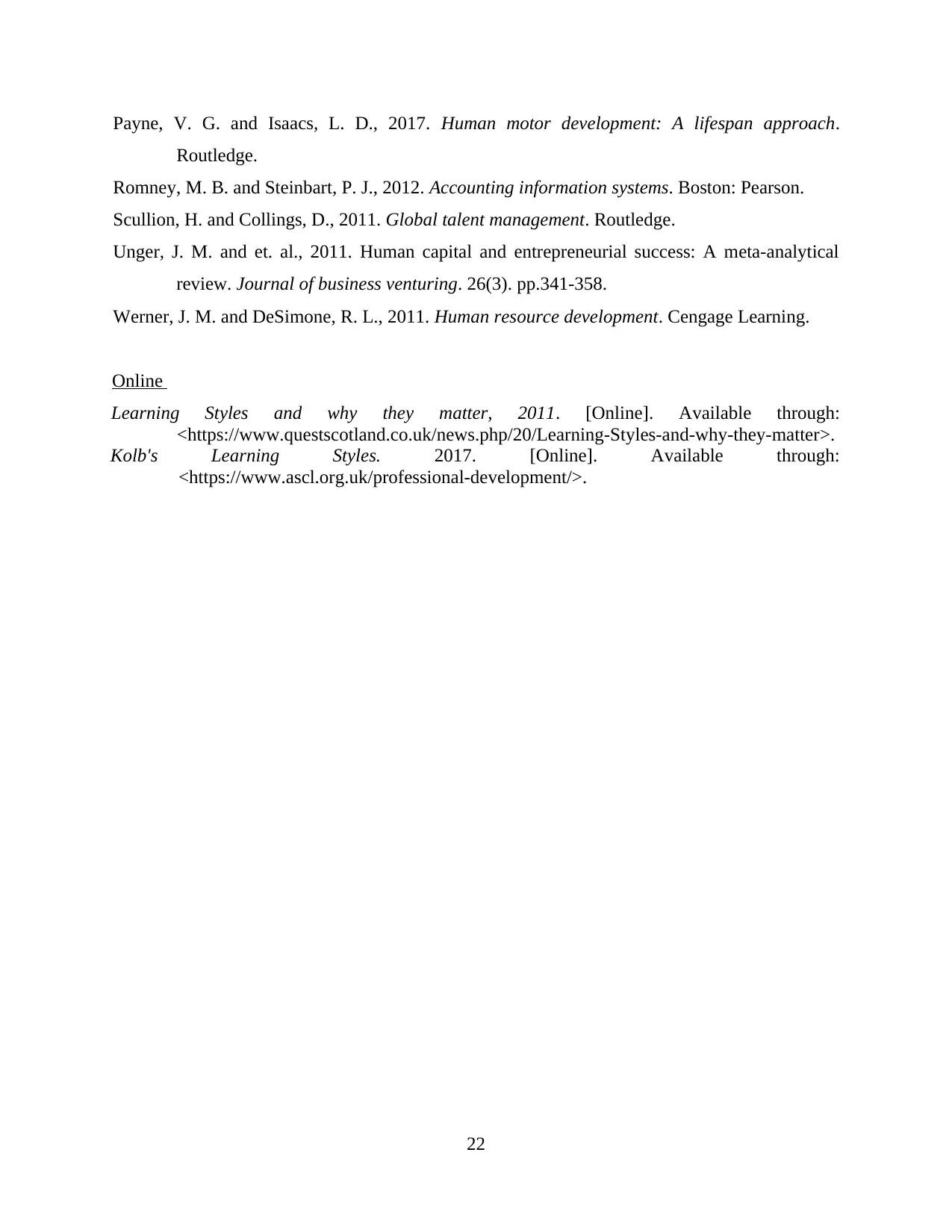
Payne, V. G. and Isaacs, L. D., 2017. Human motor development: A lifespan approach.
Routledge.
Romney, M. B. and Steinbart, P. J., 2012. Accounting information systems. Boston: Pearson.
Scullion, H. and Collings, D., 2011. Global talent management. Routledge.
Unger, J. M. and et. al., 2011. Human capital and entrepreneurial success: A meta-analytical
review. Journal of business venturing. 26(3). pp.341-358.
Werner, J. M. and DeSimone, R. L., 2011. Human resource development. Cengage Learning.
Online
Learning Styles and why they matter, 2011. [Online]. Available through:
<https://www.questscotland.co.uk/news.php/20/Learning-Styles-and-why-they-matter>.
Kolb's Learning Styles. 2017. [Online]. Available through:
<https://www.ascl.org.uk/professional-development/>.
22
Routledge.
Romney, M. B. and Steinbart, P. J., 2012. Accounting information systems. Boston: Pearson.
Scullion, H. and Collings, D., 2011. Global talent management. Routledge.
Unger, J. M. and et. al., 2011. Human capital and entrepreneurial success: A meta-analytical
review. Journal of business venturing. 26(3). pp.341-358.
Werner, J. M. and DeSimone, R. L., 2011. Human resource development. Cengage Learning.
Online
Learning Styles and why they matter, 2011. [Online]. Available through:
<https://www.questscotland.co.uk/news.php/20/Learning-Styles-and-why-they-matter>.
Kolb's Learning Styles. 2017. [Online]. Available through:
<https://www.ascl.org.uk/professional-development/>.
22
1 out of 24
Related Documents
Your All-in-One AI-Powered Toolkit for Academic Success.
+13062052269
info@desklib.com
Available 24*7 on WhatsApp / Email
![[object Object]](/_next/static/media/star-bottom.7253800d.svg)
Unlock your academic potential
© 2024 | Zucol Services PVT LTD | All rights reserved.





